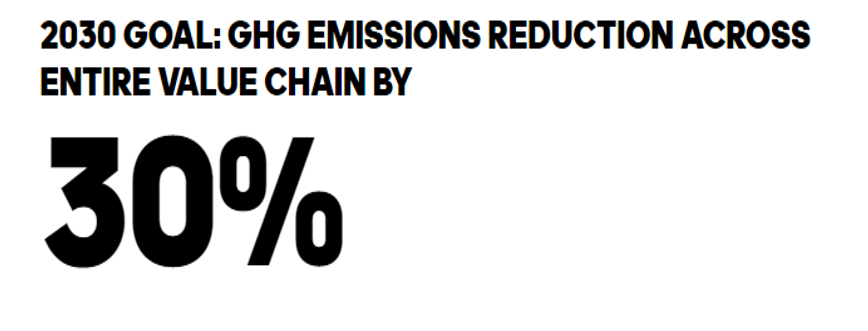EVALUATION OF SUSTAINABILITY PRACTICES ADOPTED BY GLOBAL CORPORATIONS TO STAY COMPETITIVE – CASE STUDY OF ADIDAS
Chapter 1: Introduction
1.1 Background
Sustainability refers to the practices that are being considered in the business without negatively impacting on the community, society as well as the environment. From the research, $26 trillion businesses are possibly improving economic development along with attaining competitive advantage while adopting green practices (Yaqub, 2022).
Moreover, in the study of Americans on the requirement of sustainability, 65% of Americans wish corporate entities to continue driving social and environmental changes, and before making purchases, 61% of the US customer base considers sustainability (Yaqub, 2022). Apart from this, 73% of Americans would stop doing business with a company, which ignores environmental issues (Yaqub, 2022). Furthermore, from the support of the entire business process, sustainability along with competitive edge can be maintained in an organisation.

Figure 1: Requirement of integrated business process for sustainability in corporations
(Source: McKinsey, 2022)
It is no surprise that Generation Z and the Millennials are not the same in terms of requirements and favouring trends, but when it comes to environmental concerns, the thought pattern is indeed very similar. This resulted in organisations with the incorporation of sustainability, which has a positive impact on brand loyalty, customer retention, and increased revenue; it automatically leads to offering a competitive advantage over competitors (Denga et al. 2022). For example, Adidas is a very renowned global corporation, which is loved by consumers due to their brand perception along with extensive sustainable stories. Adidas has learned many valuable lessons over the course of its 70-year history, one of which is climate change (Port, 2021).
Figure 2: Sustainable goal of Adidas
(Source: Adidas, 2021)
Moreover, the company has been a sustainability transformation leader for over 20 years (Port, 2021). The brand was the first company to bring eco-innovations towards the mass market, and pioneered ground breaking measures such as “Leather Working Group”, “Fair Labour Association”, and “Better Cotton” (Port, 2021). All of these are contributing to the company’s sales, which is accounted to be approximately €21.23 billion (Tighe, 2022).
Therefore, the following investigation will be taken strategically based on the initiatives, measures along with practices undertaken by global corporations specifically focusing on Adidas throughout.
1.2 Rationale
Corporate sustainability plays a very vital role in both social and economic demands of a population, which can improve based on the practices and initiatives considered by global corporations (Goralski and Tan, 2020). In this context, it has been identified that Adidas has taken the help of innovation in maintaining sustainability in their organisation. Collaborations with “Parley network” as well as the “Fashion for Good” innovation platform, among many others, have resulted in a number of most influential and effective projects, which are suggesting increasing sustainability measures (Port, 2021). Apart from this, to adopt sustainable practices in the organisation, Adidas has completely focused their practices on 100% cotton initiatives along with reducing the energy target by 20% in 2020 (Port, 2021). Apart from this, in terms of effectively collaborating with the labourers they have ensured safe and fair working conditions in their supply chains by employing 50 specialists for every supplier country (Port, 2021).
On the other hand, the notion of ethical and unsustainable practices in the footwear industry is not hidden. There has been a constant footwear addiction, with 24.2 billion shoe pairs produced in 2018 on its own, as well as the industry’s global revenue is also expected to reach $500 billion by 2027 (Christie, 2021). The thriving footwear industry accounts for 1.4% of global GHG emissions, or 700 million megatons of carbon dioxide emissions (Christie, 2021).
Along with a massive environmental impact, the industry is notorious for its merciless removal of non-renewable raw materials. Adding to this, there has been manufacture of dangerous and non-recyclable waste, reflecting that there are few companies who are still having poor understanding of sustainable practices (Tsai and Jhong, 2019).
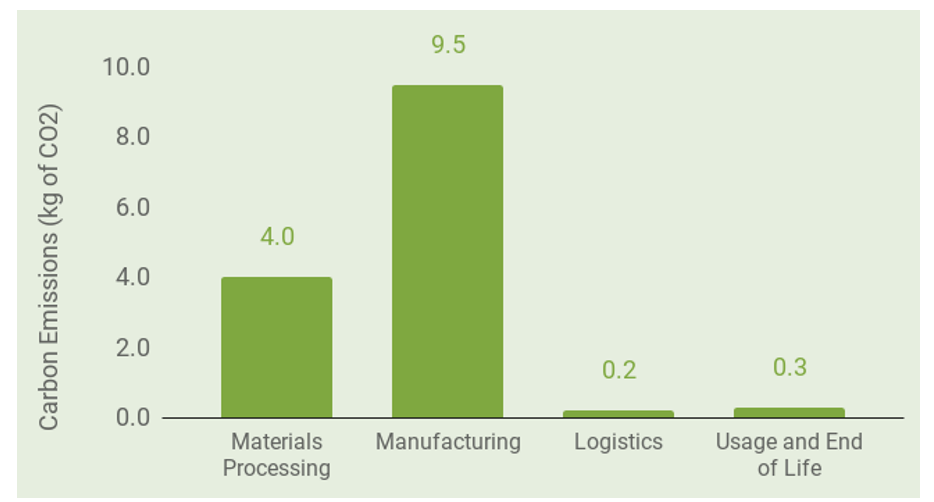
Figure 4: Carbon emission in each stage of footwear product
(Source: McLoughlin, 2021)
Moreover, even though Adidas has been committing to ecological standards and sustainable practices, the brand is still utilising few of the items, which are harmful for the environment and society as per Forbes (Danziger, 2019). It has been identified that Adidas has been taking new initiative in which they are utilising virgin polyester products by 2024. According to market research firm Plastic Insights, polyester is taken into account for 55% of the worldwide fibre industry (Danziger, 2019). Moreover, the context of recycled polyester and virgin polyester is completely different, recycled polyester prevents ocean plastic growth and does not rely on oil; however, virgin polyester might be harmful for skin (Winterich et al. 2019).
All over from the rationale, it has been identified that there are no such sustainable issues correlating with Adidas, as they are doing their best to improve and commit to the society, which brings a less contradictory rationale. Thus, it can be apprehended that with extensive expertise, Adidas is still having some drawbacks in their sustainability initiatives, which will be investigated further in this research in the preceding chapter effectively.
1.3 Research problem
Sustainability has been understood as one of the most significant aspects of a business, which can allow the company to become effective with their operation along with productivity in the marketplace. Apart from this, it has also been identified that with sustainable practices and measures, businesses can attract a new customer base, as the demand for sustainability and CSR practices are trending today.
In this relation, the problem statement of this research is to analyse the sustainable practices, which are being considered by global corporations for attracting competitiveness towards the brand. Apart from this, sustainability is a much more complex term, which needs to be integrated in a business; therefore, it will be very interesting to witness the challenges that are being faced by global corporations while integrating sustainable approaches as well. Moreover, advantages and disadvantages that are interrelated with sustainable practices will also be investigated, which comes up to be an area of critical investigation for this current research.
1.4 Aims and objectives
The aim of the present research study is “to investigate the sustainable practices that are being considered by the global organisation in terms of attaining a competitive edge”. Apart from this, to have a precise way of investigation, Adidas has been selected to be the company to investigate further in this research.
The research objectives are structured below:
- To measure the significance of sustainable practices in global corporations for attracting competitive advantages
- To explore the challenges that are being faced by Adidas in maintaining a sustainable approach in their organisation
- To investigate the advantages that can be attained through the help of sustainable initiatives in global corporations
1.5 Research questions
The research question for this study is:
- What are the current sustainable practices trending at the global marketplace, which are allowing the corporation to bring productivity and competitive advantages in the marketplace?
1.6 Significance of the study
From the research investigation until now, the idea has been procured that sustainability is not just a simple term as it can be taken as a concept, which can improve business productivity while offering them a great success in a global marketplace. In this relation, the significance of the research is immense, as this research is important and the topic offers a great and extensive idea of sustainability and its practices.
Apart from this, through these researchers the readers will be able to improve their viewpoint regarding the research context along with potential strategies that are being considered as well. Furthermore, the concept of sustainability is interesting due to growing environmental concerns; thus, this would help future researchers to construct a study in the same area with effectiveness. Other than this, through this research, variants of data will be gathered, which will allow in improving the knowledge and development of researchers.
1.7 Description of method
The investigation will be conducted through secondary research, which is supported by “interpretivism research philosophy”, “descriptive research design” and “inductive research approach” respectively. Apart from this, data collection of the research investigation is done through the help of “secondary data collection method”, which is also supported by “thematic analysis” while generating themes specifically indicating research aim. Through secondary research, the researcher is going to address the main purpose of the investigation while mitigating the research problem. Furthermore, a “qualitative research strategy” has been followed in this investigation, which is supported by a chronological and systematic procedure.
1.8 Dissertation structure
In this dissertation, the chapters will be covered strategically and chronologically with introduction, literature review, methodology, data analysis followed by conclusion and recommendation. All the sections will have a direct relationship with each other referring to the research objective and research question specifically. Introduction chapter has offered a brief background, whereas the literature review will be full of argumentative approaches of different authors undertaken by Google Scholar.
Apart from this, the methodological section will provide an overview of the data collection, which will be analysed and interpreted in the next chapter of data analysis respectively. The final chapter of conclusion and recommendation will provide a brief overview of suggestions along with a summary of the entire investigation.
Chapter 2: Literature review
2.1 Introduction
The concern regarding sustainability has increased among global corporations, as the initiative of organisations regarding sustainable development influences their competitive advantage. In this regard, opinions, and perspectives of different authors regarding sustainable development practices of global companies and their impacts on competitive growth would be analysed critically.
Theoretical assumptions regarding sustainable practices and their entrance in enhancing competitive growth of organisations would also be illustrated in this section. After that, the significance of sustainable development practices in the footwear industry would be evaluated critically. Issues faced by global companies while maintaining sustainable approaches can also be analysed to address research objectives. Sustainability trends in the footwear and apparel industry would also be evaluated. Lastly, limitations for this current chapter would also be mentioned.
2.2 Conceptual framework
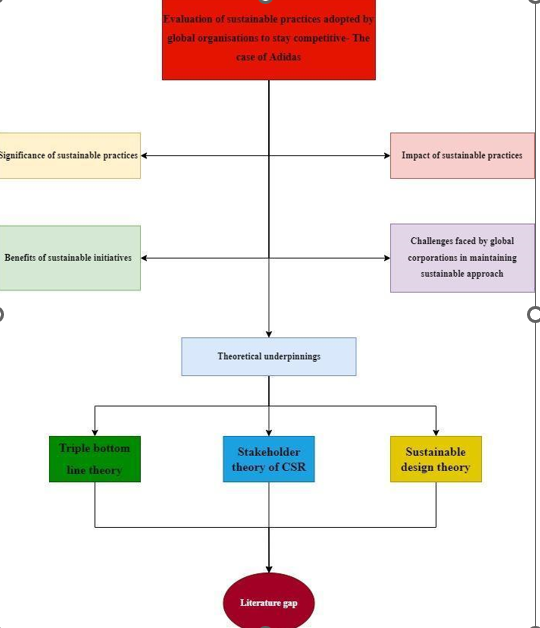
Figure 6: Conceptual framework
2.3 Theoretical analysis
2.3.1 Triple bottom line theory
Concerning the following research investigation, the topic is about sustainable practices and initiatives; therefore, it is important to understand the importance of sustainability that is related to the community, society as well as the environment. In this regard, the “Triple bottom line” theory has been considered to evaluate the entire context of this topic while being argumentative with the approach of the sustainable initiative in global organisations.
The “Triple bottom line” is a theoretical context that suggests organisations to improve their services and operations specifically focusing on the environmental aspect (Shim et al. 2021). It has been found that the bottom-line theory suggests a business to operate successfully while establishing initiatives to protect people, the planet, and profit from any future challenges (Shim et al. 2021).
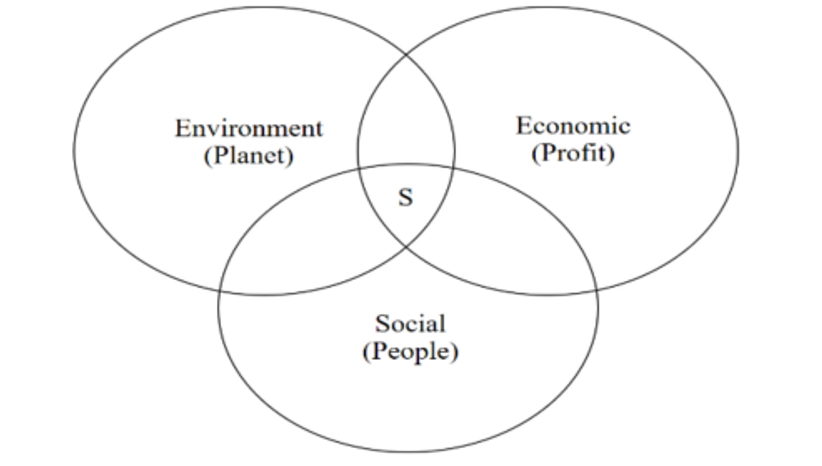
Figure 7: Triple bottom line theory for sustainability
(Source: Shim et al. 2021)
From this perspective, it can be understood that with the help of this theoretical understanding organisations can improve their focus on people by undertaking sustainability tactics, which would help in successfully maintaining a balance between the profitability as well as the sustainable approaches. In other words, this would positively help in increasing profit, which further would contribute in gaining competitive advantages. In the current competitive marketplace, there is full of ambiguity and uncertainty as there are economic downturns, climate change along with deadly viruses such as the Covid-19 pandemic that also influence sustainable approaches of global businesses (Ali and Davis-Floyd, 2022)
. In this context, businesses are required to understand sustainable practices in an organisation, which can help in supporting the entire environment positively. It is very important to have a sustainable business strategy, which can help to improve corporate brand loyalty along with addressing concerns. Therefore, the “Triple bottom line” theory will be an effective approach for the footwear and apparel manufacturers to act appropriately.
2.3.2 Stakeholder theory of CSR
The current study is about sustainable practices adopted by global footwear and apparel companies to enhance their competitive advantage. In this regard, the evaluation of perceptions of “Stakeholder theory of CSR” can help significantly. This theory suggests that businesses should take responsibility to satisfy all their stakeholders such as employees, investors, suppliers, community, and customers (Mahmud et al. 2021).
In this regard, the research of López‐Concepción et al. (2022) indicates that the stakeholder’s theory has a separate significance in helping companies to achieve satisfying financial results while maintaining social responsibilities. Based on the ideas of the stakeholder’s theory of CSR, it can be stated that global companies need to be focused on fulfilling the requirements of all stakeholders including customers.
With this reference, it is evident that global companies from the apparel and footwear industry need to actively work for achieving sustainability, as customers’ demand in this current era depends on their concerns regarding the environment. Hence, global apparel and footwear companies can enhance their competitive advantages with the help of sustainable approaches that have the ability to satisfy the needs of customers.
2.3.3 The sustainable design theory
In accordance with the study of Baldassarre et al. (2020), the sustainable design theory provides the importance of knowledge regarding how societal, as well as environmental challenges can be addressed by three thinking about products and business processes more broadly.
On the other hand, this theory also provides importance on a sustainable socio-economic system that should be considered by global organisations while operating business (Baldassarre et al. 2020). The perception of this theory has been reflecting that they can be utilised while discussing the concern regarding sustainable approaches of worldwide footwear and apparel companies.
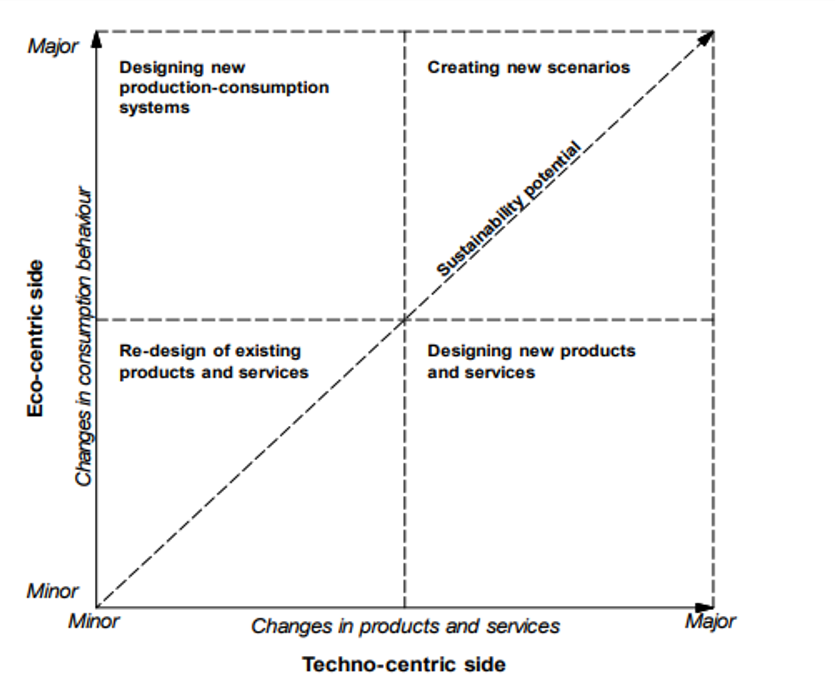
Figure 8: Approaches of sustainable design in the context of sustainability or sustainable development
(Source: Grover et al. 2019)
As per the opinion of Grover et al. (2019), sustainable design theory helps businesses to adopt sustainable development strategies. Based on the understanding of this theory, it can be stated that the main three pillars of sustainable design are economic sustainability, social sustainability, and environmental sustainability. Hence, these pillars should be considered by companies in the footwear and apparel industry while they are focusing on sustainable development, which would help them to impact the environment positively and gain competitive advantages as well.
2.4 The concept and significance of sustainable practices in global corporations
The concept of sustainable practices in the workplace is a method that is being used by several global organisations in the footwear industry all around the globe to maintain sustainability and reduce the harmful effects of their companies on the environment (Ashrafi et al. 2018). The adoption of sustainable practices by global corporations provides them with the ability to enhance their brand image, which significantly affects their competitive position in the market. Accordingly, sustainable practices also enable them to minimise costs and increase productivity within the manufacturing units of global corporations. Hence, adopting this approach allows the companies to reduce the negative impact on the environment while also providing them with the benefit of making a profit (Ashrafi et al. 2018).
Accordingly, this method of sustainable practices in organisations is based on their work criteria and objectives. According to Barreiro‐Gen and Lozano (2020), it has been concluded that the mode of internal efforts in sustainable practices highlights the procedures adopted by the organisations such as recycling programmes, reducing the use of energy in their factories, and switching to natural gas or electric vehicles.
On the other hand, the concept of external sustainable methods highlights the procedure in which organisations change materials used to create products to reduce the harmful impact on the environment. The concept of external sustainable practices in a global organisation also includes alteration of vendors and suppliers that might have a huge impact on the environment and their work structure (Saeed and Kersten, 2019).
It has been noted that the majority of global corporations in the footwear industry consider sustainable business practices as CSR. As a result, it provides major benefits to an organisation in terms of achieving competitive advantages and being profitable in the market.
As per the studies of Martins et al. (2019), it has been found that the concept of sustainable business practices in global cooperation has major significance, as the concept of sustainability is most preferred aspect for individuals from different parts of the globe.
There is an increasing effect of certain climate changes all around the globe that is affecting majority of lives around the planet (Saeed and Kersten, 2019). Therefore, the concept of sustainable business practices in global corporations in the footwear industry is becoming more important for owners, leaders, and administrators as well as the customers that are related to an organisation.
According to Aboelmaged and Hashem (2019), there has been a major significant effect of sustainable practices on global organisations, as it provides rent value and competitive advantages to the organisations that are operating in the current market scenario. It also enables global corporations to meet consumers’ demands based on sustainable standards and a positive impact on the environment.
Apart from that, the significance of sustainable practices in the sports footwear and apparel global organisations is that it provides them with the ability to increase efficiency within the workforce as well as attract new talents to enhance productivity and performance (Narwane et al. 2021). Thus, the adoption of sustainable practices enables them to minimise costs in the operational units which results in increasing financial revenue and performance of the organisational management in the global level.
Thereby, it allows them to grow and expand without necessarily requiring extra resources and other advantages in the market (Narwane et al. 2021). Hence, there has been significant importance of sustainable practices in business throughout the globe on environmental attributes and consumer demand. Thus, sustainable practices are one of the major aspects for global organisations to become successful in the market and increase their profitability ratio, which might also impact their overall revenue.
2.5 Impact of sustainable practices in global corporations in achieving competitive advantage
A global corporation is considered sustainable in case of being financially viable, socially ethical, and ecologically acceptable. Embracement of a socially responsible and ecologically sustainable business strategy often directly contribute to the development of sustainable economic ideals (Siregar, 2021). The footwear industry is coming under growing pressure from its many stakeholders to prioritise sustainability and accept responsibility for its multiple bottom line (MBL) operational methods, which include economic, environmental, governance, social, and ethical practices.
As a result of the five sustainability objectives being integrated into business practices, there has been a considerable shift in the company’s viewpoint since the notion of sustainability first emerged (Siregar, 2021). A sustainable business is one that integrates its business strategy to achieve a holistic development that improves firm performance and takes into account the long-term effects of its activities.
Based on the studies of Lahti et al. (2018), it has been concluded that there are major significant impacts of sustainable business practices in global corporations, as it provides the organisation to increase the use of digital and innovative tools within the workforce and management of an organisation. Hence, it increases the use of digital technology by global organisations in their workplace, which results in impacting their performance and productivity (Camilleri, 2022) As a result, the utilisation of an increasing amount of digital technology within the workforce provides them with the ability to enhance their competitive standards in the market.
Hence, creating greater environment friendly corporate practices helps to boost output and save expenses, improving operational efficiency (Camilleri, 2022). The major goals of businesses in the sports footwear and apparel sector have shifted from profit maximisation to create value for all parties, including shareholders, while keeping their social commitments. As a result, it has been found that the effect of investors expanding their assets by investing in businesses committed to sustainability through corporate social responsibility.
Hence, the impact of sustainable practises is increasing the number of investors that are drawn to this sort of business; because it promises to increase shareholder value over the long-term by seizing opportunities and controlling risks brought on by ongoing improvements in the economy, environment, and society.
In accordance with the studies of Ganda (2019), it has been found that the adoption of sustainable practices by global organisations also impacts the use of energy mixture, energy distribution and energy consumption by the organisations.
Thus, it also provides a significant advantage for global corporations, as it helps in reducing the use of resources that cannot be recycled. Hence, it increases the brand value and reputation among the consumers in the market, which enables it to have a greater customer retention rate than the competitors in the market. The second most important impact of utilising sustainable practices by global corporations is its capabilities of reducing the amount of pollution towards air and water in the form of material sourcing and manufacturing.
As per the studies of Khan (2019), it has been concluded that there has been a significant impact by using sustainable practices by global corporations to reduce carbon footprints. On the other hand, the effect of sustainable practices in international organisations in the footwear sector leads to responsible procurement of materials for reducing environmental impact.
As a result, it has been emphasised that it is more important to make sure that business partners support fair-trade agreements; since doing so may have a significant influence on the company’s social impact. Additionally, by focusing on the packaging or optimising their production process to decrease plastic waste, multinational organisations may lessen the number of natural resources they use (Kakadellis and Harris, 2020).
As a result, it lowers the organisational carbon emissions by expanding the installation of sensing devices in their buildings, which may make sure that energy, heating, and cooling are turned off automatically when not needed.
2.6 Potential benefits of sustainable initiatives in global corporations
The concept of sustainable practises provides several benefits for companies, including helping them become more effective, competitive, and lucrative (Boakye et al. 2020). One of the main benefits of global organisations implementing sustainable practices in the footwear sector is that it helps to enhance brand image and gives firms a competitive edge.
Therefore, the majority of businesses adopted a number of sustainable practices that gave them an edge in drawing clients to their goods and services. According to the findings of Anwar and Abdullah (2021), it has been shown that doing business grows simpler as time goes on in the competitive marketplace by the utilisation of sustainable practices. On the other side, it has been reported that implementing sustainable practices helps multinational businesses to cut costs and boost efficiency in the workplace (Yong et al. 2020).
Therefore, the creation of sustainable company practices facilitates an efficient functioning that optimises attempts and helps conserve materials, which boost employee performance and reduces costs. However, the benefit of cost-saving measures also includes energy-saving techniques; this can range from straightforward measures like turning off lights by the utilisation of innovative sensors to save energy, enclosing walls to more complex ones like installing solar panels that help in powering the air conditioning and heating technologies (Abd Rahman et al. 2021).
Another significant benefit in this case reflects the ability of adopting sustainable practises by multinational firms to draw in new clients and boost sales. Thus, it has found that the utilisation of sustainable business practises can increase a company’s marketability in the competitive market (Kilu and Sanda, 2020). It has also been observed that customers in the contemporary market context are increasingly environmentally sensitive.
Sustainable business practises may really improve how well multinational organisations perform in addition to boost organisational profitability. The organisational management can have a lower carbon footprint with the emission of fewer poisons into the atmosphere by making modifications.
As a result, it benefits an organisational staff to promote their brand while focusing on the idea that cleaner air and drinking water, reduced waste, and more renewable sources of energy would eventually benefit future generations (Naim, 2021). The potential of sustainable practises to effectively decrease waste output to be implemented by multinational organisations is their most important advantage. Therefore, there is less likelihood of resource waste when organisational management promotes sustainable manufacturing. As a result, it enables organisational management to use resources that can be recycled, making it more sustainable and ecologically beneficial.
With reference to the studies of Manavalan and Jayakrishna (2019), it has been noted that it improves system and organisational supply chain operations, which helps in increasing the usage of recyclable resources. Additionally, it helps businesses to offer workers enough training and development programmes for utilising cutting-edge technology and inventive aspects that enable them to give recyclable resources priority (Manavalan and Jayakrishna, 2019). Contrarily, the idea of sustainable practices, which are being embraced by multinational firms in the footwear sector, offers a substantial advantage in luring investors and potential workers.
As a result, the vast majority of investors on the global market are focused on placing their money with businesses that integrate sustainable standards into their supply chain and management systems (Cantele and Zardini, 2018). The majority of customers are increasingly drawn to businesses that are committed to uphold sustainable standards, which is leading to a considerable increase in their financial performance and income. As a result, in order to maximise their returns from the businesses, investors and workers concentrate on enterprises with a larger client base and stronger brand recognition in the marketplace.
Governments also provide organisations that focus on environment friendly issues major benefits in terms of taxation regulations as a result of the abrupt climatic changes and environmental repercussions around the globe (Truby, 2018). Therefore, one of the key benefits that are being implemented by numerous organisations all over the world is the decrease in taxes, policies and gathering other benefits from the government to maintain sustainable standards.
2.7 Challenges faced by global organisations in maintaining a sustainable approach in their organisation
In accordance with the study of Haseeb et al. (2019), in this post-modern era of industrialisation, sustainable approaches play the most vital role in achieving success in a competitive business environment. However, global organisations face different kinds of challenges in maintaining a sustainable approach in their organisation.
For instance, in maintaining organisational cultural aspects that are supporting their sustainable development, global companies can face issues. In this regard, the research of Haseeb et al. (2019) indicates that negative beliefs as well as values within an organisation, have the ability to adversely impact the approaches for sustainable development. This further influences the competitive advantage along with the overall business performance of organisations. As per the opinion of Furstenau et al. (2020), global societies are facing different challenges in conducting sustainable development due to the aspects such as energy consumption, food demand, agriculture crisis, overpopulation, production waste, and water supply.
These issues have been influencing global companies to adopt sustainable approaches to meet consumer demands from the perspective of sustainability (Furstenau et al. 2020). This is indicating that companies like Adidas operating in the sports footwear and apparel industry can face issues regarding organisational culture; especially, regarding the values and beliefs while trying to achieve their sustainable development objectives.
Apart from that, organisational culture is basically a mixture of the perceptions of managers regarding any problem, which can also influence the sustainable development approaches negatively. For instance, if managers of a company do not trust and support the use of technology in sustainable approaches, that would undoubtedly influence the overall approach regarding sustainability in a negative manner (Haseeb et al. 2019). It is evident that the use of updated technologies such as data analytics has a separate significance in achieving sustainable development goals by global companies.
In this regard, the research of Furstenau et al. (2020) also illustrated that industry 4.0 has been playing a crucial role in providing opportunities to build sustainable organisations. Similarly, the opinion of Strandhagen et al. (2022) also indicates that industry 4.0 has a great influence on the sustainable development approaches of global companies, as digital solutions help businesses in their sustainable development. From this, it can be stated that global footwear and apparel companies can face issues in the use of technology in their sustainable approaches because of the differences in managerial perception.
It has been noted that there are a number of difficulties in sustaining a sustainable approach in organisational management as businesses from various sections of the global footwear industries focus on more sustainable standards (Moktadir et al. 2018). Although, in the global market, sustainable centres have been giving the footwear sectors substantial benefits.
It is, nevertheless, also providing a sizable challenge to the organisational administration in the footwear sector. Therefore, issues with government laws and concerns that are being put in place for the footwear industry in their production facilities may also occur (Islam et al. 2021). It has been highlighted that there has been a major increase in development procedures, which necessitates time and money from the organisational management in order to maintain sustainable standards and adjust to significant changes as per the government laws.
The research of Strandhagen et al. (2022) has also identified issues related to sustainability to be influenced by working conditions, communication as well as supplier relationships, and energy consumption. Despite different challenges, the sustainable approach of global companies has been providing them with several positive impacts such as positive consumer attributes creation, brand reputation, cost-effectiveness, and some others (Oláh et al. 2018). Therefore, it is clear that companies worldwide have been facing different challenges in maintaining their sustainable approaches, which need to be overcome for gaining remarkable competitive advantages.
2.8 Existing sustainability trends in the footwear and apparel industry
As per the opinion of Woodside and Fine (2019), in this current era of globalisation, “sustainable fashion” or “eco fashion” has become a trend for the global population, as it supports sustainability. Approximately 8,000 chemicals are utilised in order to turn raw material into textiles, which causes damage to the environment (Woodside and Fine, 2019). This is indicating that the apparel and footwear industry, along with their manufacturing process is causing damage to the environment. This is the reason that global customers are supporting trends such as sustainable fashion.
On the other hand, the study of Asabuwa Ngwabebhoh et al. (2021) reflects that footwear is one of the leading sectors in the global fashion industry, which is focusing on sustainability in order to meet customer demand. To be more specific, customers’ perception regarding the use of eco-friendly products has been influencing the footwear industry by creating a new trend regarding the use of sustainable materials in products such as clothes and shoes.
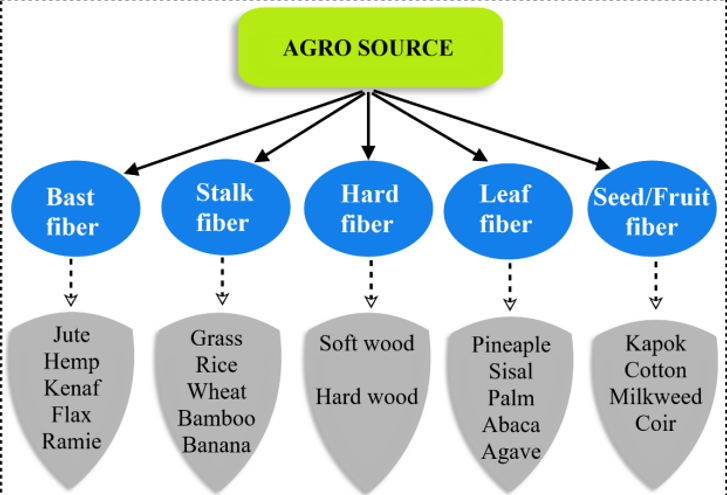
Figure 9: Agro source used by footwear and apparel companies to support sustainable fashion trend
(Source: Asabuwa Ngwabebhoh et al. 2021)
Findings reflect that in 2015, materials such as synthetic leather possessed a worldwide market worth of approximately US$22 billion, which is assumed to reach approximately US$85 billion by the year 2025 (Asabuwa Ngwabebhoh et al. 2021). However, increasing environmental and climate change regarding hazards has become one of the major problems which are leading global footwear companies to find new alternatives for leather (Asabuwa Ngwabebhoh et al. 2021).
This trend of finding new alternatives for leather has pushed leading 10 footwear companies such as Adidas, Nike, and Burberry to enhance their interest in vegan or agro derived leather alternatives. Similarly, the research of Mazotto (2022) has been indicating that leading footwear and apparel companies such as Nike, Puma, and others have taken initiative in the development of eco leather materials with the help of agro derived fibres that are blended with vegetables.
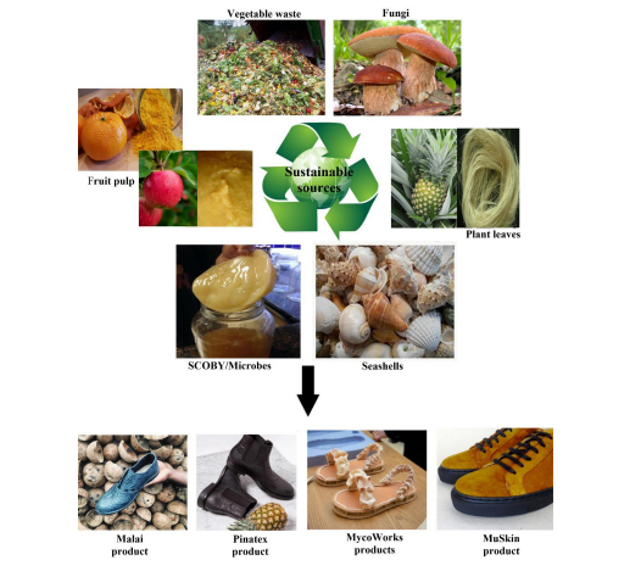
Figure 10: New-generation fibre sources and products supporting sustainable fashion trends in the global footwear industry
(Source: Asabuwa Ngwabebhoh et al. 2021)
Based on the above figure, it can be stated that there are significant fibre sources and products that provide the ability for the global Footwear industry to focus on sustainable factors in their supply chain (Asabuwa Ngwabebhoh et al. 2021). Hence, it can be stated that this focuses on adapting to the new generation fabric sources on developing footwear in a sustainable manner.
Whereas, the global footwear industry also focuses on sourcing materials from different sustainable sources that enable them to maintain sustainable standards in the packing area also (Rathinamoorthy and Kiruba, 2020). As a result, it attracts consumers from different parts of the world to focus on the sustainable standards which are being maintained by the footwear industry. In accordance with the study of Zavodna and Trejtnarova (2021), shoe packaging has been going through several redesigning processes by leading sports footwear and apparel companies, which is influenced by green design and the modern trend of sustainability.
Green designing in packaging of shoes has become a trend in the global footwear industry as it aims to recycle, reuse, and reduce materials that are utilised in order to make packaging. On the other hand, the study of Zavodna and Trejtnarova (2021) also indicates that changes in the customer’s mindset regarding eco-friendly packaging have also been influencing footwear companies to adopt this trend and be focused on green packaging.
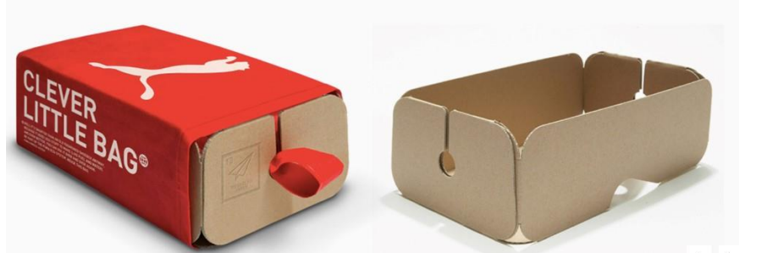
Figure 11: New trend in the packaging of shoes
(Source: Zavodna and Trejtnarova, 2021)
As referred to in the above figure, it can be stated that the majority of the footwear brands in the international market are focusing on sustainable standards of packaging systems. Therefore, it enables them to eliminate the maximum amount of cardboard which was being used at earlier times for Footwear packaging. Hence, the design and the shape of the packaging bags have also been changed by the international footwear industries in order to maintain sustainable standards and fulfil the consumer’s demands regarding the requirements of the packaging (Das et al. 2022).
Thereby, it is being noted that it provides the ability to the international footwear industry to add up to sustainable sourcing of materials in their packaging systems such as paper and cardboard. In accordance with the sustainable procedures, it provides the ability to the international footwear industry to attract consumers based on sustainable factors and advertising strategies on sustainability.
However, it is evident that cardboard, as well as paper, are considered as oldest materials that have been covering the largest portion of new designs or green packaging in the sports footwear and apparel industry (Zavodna and Trejtnarova, 2021).
This is because, the use of cardboard and paper is supporting sustainability and fulfils customers’ demands regarding sustainable packaging. From the discussion, a clear influence of sustainability regarding perceptions of customers is noted, that are pushing global footwear and apparel companies to adopt sustainability trends, which is also contributing in gaining competitive advantages.
2.10 Literature gap
The entire research investigation has focused on sustainable practices and their supportive aspect of competitive advantage; specifically, discussing the footwear and apparel industry. Hence, due to the limited research area, wide argumentation of literature review with considering different information of different industries has not been included by the researcher.
Furthermore, as the research was only based on sustainable approaches, other aspects such as employee training programs, quality management, efficient integration among the organisation and the HRM, and many others have been ignored, which also can contribute to enhance competitive advantages. Apart from that, a few of the research articles have not been effectively undertaken due to subscription issues, which have limited the outcome of this chapter.
2.11 Summary
Based on the knowledge of the entire chapter, it can be summarised that the importance of sustainable practises is significant since it influences the overall performance of the multinational firms in the footwear sector.
Additionally, in order to encourage better study findings, possible benefits of sustainable practises have been highlighted above, including tax advantages, waste reduction, investor attraction, increased productivity, and cost savings. Poor revenue and ineffective management have been identified as problematic project management characteristics that have a negative impact on performance.
The triple bottom line theory, stakeholder theory of CSR, and other theories have been favourably included for reflecting an effective perspective of the research. Additionally, a variety of issues, including the requirement for effective workforce management and organisational development, has been pressuring organisations to concentrate on sustainable practises. In addition, organisations around the world have used efficient inventions and tools, like solar panels, to enhance their overall sustainable business practises and promote organisational growth.
Chapter 3: Methodology
3.1 Introduction
The following chapter of methodology has been constructed based on different collected methodological approaches by researchers in order to complete the entire study effectively. With the help of research methodology, the researcher is able to provide smooth and effective research context, while specifically focusing on the study’s objectives and questions significantly.
Through the utilisation of appropriate research methodologies, the researcher is able to address the research problem while preventing any future challenges with the support of ethical considerations. In relation to this, the following chapter would be based on different research philosophy, design, and approaches with appropriate justifications.
Furthermore, the data collection method and its analysis, which has been reflected in the following chapter, have massively supported the researcher in terms of analysing and interpreting the research context effectively while generating evidence that strategically reflects the research purpose and aim.
3.2 Research onion
Research onion is a systematic approach, which helps researchers in terms of designing a research methodology. Adding to this, research onion supports the researcher with a pictorial design that helps to examine and plan the research approaches while undertaking them in terms of decision-making along with implementing them effectively (Saunders et al. 2019).
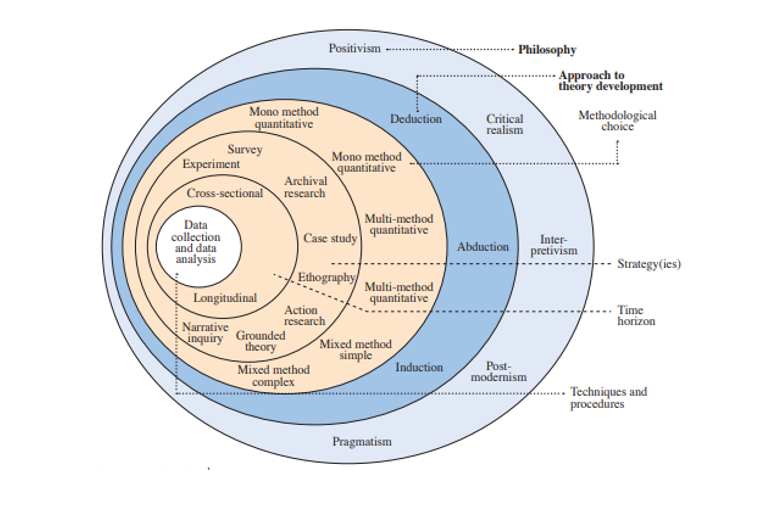
Figure 12: Research onion
(Source: Melnikovas, 2018)
As mentioned in the figure above, it can be stated that research onion has a few layers, which consist of philosophy, approaches, methodological choice, strategies, time horizon, and most importantly, its core depicts data collection method (Melnikovas, 2018).
With appropriate approaches and designs, a researcher is possibly able to improve their research assumptions and interpretations, which helps in developing great research findings. Furthermore, it can be understood that with the support of research onion, the researcher is able to illustrate step-by-step plan with methodological approaches while focusing on every different aspect with in-depth understanding and interpretation (Orth and Maçada, 2021).
3.2 Research philosophy
Research philosophy helps in enhancing researcher’s problem-solving capabilities along with offering a wide concept regarding the research arguments and problems (Zhang et al. 2021).
Through the help of research philosophy, the researcher is able to deal with the issues along with extracting essential information from a wide range of sources of data. Moreover, with research philosophy, the researcher can be able to understand the nature of research along with the development of knowledge that helps in constructing the phenomenon of the research to be done (Muhaise et al. 2020).
It has been investigated that there are specifically two main types of research philosophies that are being considered by researchers in terms of conducting a methodology. Among them, interpretivism and positivism research philosophy are the primary ones (Gatley et al. 2020). However, in terms of constructing the current research, interpretivism research philosophy has been undertaken to address the research purpose in an efficient manner.
Justification
The reason behind undertaking interpretivism research philosophy is to offer the research context with a naturalistic approach. The purpose and aim of the research have been addressed through the support of interpretivism research philosophy (Alharahsheh and Pius, 2020). The researcher has been able to understand the abstract description of the research context, specifically the sustainable practices adopted by Adidas while ensuring reality with actual organisational context.
Moreover, with interpretivism research philosophy, the researcher has become an interpretivist with having an analysis completely based on the validity that is closest to the actual truth and reality (Žukauskas et al. 2018). However, interpretivism philosophy has a weakness, as sometimes it generalises the representation of data.
Nevertheless, it also has an advantage of offering an objective research, which has allowed the researcher to construct the study with appropriate nature and approach to mitigate the research objectives and questions without biasness (Ikram and Kenayathulla, 2022).
3.3 Research approach
Research approach plays a crucial role in assigning different meaning to the research while conducting a study. The relevance of distinctive approaches can improve the validity of the assumptions along with contributing to generating new theories along with efficient facts and information about the research explanation (Yin and Li, 2018).
It has been identified that research approaches can be categorised into three different sections such as deductive approach, abductive approach, and inductive approach (Koltay, 2019). In the case of current research study about the sustainable practices adopted by global corporations, the inductive research approach has been considered by the researcher that has also been seamlessly integrated with other methodological stances.
Justification
The reason behind considering an inductive research approach is for its efficacy in comprehending research context along with generating untested conclusions. Moreover, with an inductive research approach, the researcher is able to understand the actual process of data collection, which explains the phenomenon of the research while identifying themes and the pattern of conceptual framework (Brantnell and Baraldi, 2020).
Adding to this, researchers have developed their observation referring to the actual process of the research that helps in structuring the entire pattern of the study. Furthermore, with an inductive research approach, the researcher can get a bird’s eye view, which supports to understand the research problem closely while addressing each of the research objectives and questions specifically (Van Burg et al. 2022).
Moreover, the researcher has improved the idea of the problem area that has been closely looked into through literature review and data analysis by collecting sufficient data. Apart from this, the basic strength of the inductive approach, which has become the key reason for researchers being attracted to this approach, is its prediction of the future while establishing possibilities to prevent it from any false accusations and conclusions (Shankar and Clausen, 2020). Furthermore, it can be stated that with this research method the researcher is able to get more engaged with the research topic while becoming interested in developing outputs that can refer to analytical thinking and information.
3.4 Research design
In order to successfully carry out researches, it is crucial to undertake a suitable as well as proper research design (Asenahabi, 2019). Research design needs to be adopted by researchers before collecting information; so that, it can help in achieving the objectives of a research in a significantly valid manner (Asenahabi, 2019). Hence, for completing the current investigation the researcher has utilised the descriptive research design.
Justification
This design can be defined as the research method that is utilised in describing existing phenomena by providing a great importance to maintaining accuracy (Atmowardoyo, 2018). Hence, with the utilisation of this research design, the researcher has been able to maintain accuracy while describing the current context of a research. For instance, the implication of this design has contributed greatly to describe the significance of effective sustainable practices in global businesses in order to attract competitive advantages, as it has the potential to assist research in describing a phenomenon with accuracy.
Apart from that, it is evident that descriptive research design has a great potential to assist researchers in answering questions that are based on how, when, where, and what, rather than only concentrating on questions related to why (Sahin and Mete, 2021). Therefore, the application of this design has a great contribution in solving the research problem, as it has assisted the researcher to provide importance to every aspect of the context while attempting to solve the current research problem.
In addition to that, descriptive research design allows researchers to interpret relevant facts and develop an in-depth as well as accurate understanding of research problems (Sahin and Mete, 2021).
Hence, with the use of this specific design, the current research has been able to acquire an in-depth understanding that is required for solving research problems properly. Based on the overall justification, regarding the use of research design, it is clear that the descriptive preserves design has contributed greatly in successfully completing the study. Hence, the use of this design is justified in terms of completing a research on the current topic.
3.5 Research strategy
Research strategy is the way through which the actual context of the research is being understood (Rutz and Watson, 2019). In this connection, referring to the philosophy, design, and approach, the qualitative approach of research strategy has been selected.
Qualitative research strategy has been referred to understand people’s beliefs, attitudes, interactions, and others while collecting non-numerical data and concepts that can gather insight of the actual research context (Thambinathan and Kinsella, 2021). Moreover, the reason behind undertaking qualitative research strategy is due to its ability of providing as much as possible information while creative approaches, subjectivity along with more opportunities for collaborations.
3.6 Data collection method
Data collection method is the way through which the researcher is able to construct the entire research study while selecting relevant information that can address the entire research purpose (Renbarger et al. 2019). In this connection, the researcher has focused on secondary data collection methods with the support of already existing information and data that are completely relevant to the current research requirements specifically. In terms of different secondary sources, the information is being taken from journals, books, public records, physical document, business document, organisational report, organisation, website, news articles like BBC, Forbes, and many others (Siddiqui et al. 2019).
The reason behind considering a secondary method is its ease of access along with a time saving approach. Apart from this, secondary data helps in generating new insight of previous analysis while saving cost and other research expenses. The literature review has been done with secondary journals and has supported the entire chapter with relevant information and previous researches of different authors (Bolander et al. 2021). Apart from this, numerous websites and statistical information have been collected by secondary sources that have successfully helped in achieving research objectives and questions.
3.7 Data analysis
With the support of a secondary data collection method, the researcher has conducted a qualitative data analysis, which is also known as thematic analysis. The researcher has keenly focused on analysing the research objective and questions specifically in order to generate themes, which has allowed to mitigate the research problem (Lainson et al. 2019).
Moreover, the researchers have specifically undertaken authentic websites such as organisational reports, in order to reflect on the competitive advantages of Adidas while promoting sustainable practices. The reason behind considering thematic analysis is its accessibility of undertaking knowledge based on approaches of research purpose. With thematic analysis, a researcher conducts the research study with flexibility in the development of large data while answering every research question and objectives structurally (Strinzel et al. 2019).
3.9 Inclusion and exclusion criteria
Inclusion and exclusion criteria play a crucial role as it helps in improving the likelihood of research’s reliability and credibility while preventing the research from any potential harm (Keung et al. 2020).
In this concern, while constructing the research, the crucial aspects that are included in this study are completely relevant information addressing research topics. The reason behind this was to prevent the study from any diversion that can influence researcher’s interpretation specifically. Apart from this, the study’s sources are based on the information that has been collected in between 5 years from 2017 to 2022.
All of the relevant and authentic websites have been considered for this study such as a business report, organisational website, BBC, and many others. Concerning exclusion criteria, unauthentic websites such as blogs, Wikipedia and any educational websites are excluded for this study, as it might influence research results while providing false information.
Apart from this, sources prior to the year 2017 have been excluded specifically for this research study, as those information does not have latest information. Moreover, outdated sources could have never helped in researching the research problem with adequate and informed data about the sustainability practices adopted by Adidas specifically.
3.10 Ethical consideration
It is very important to abide by the ethical consideration of a research while designing and practising a research study. It is crucial that the researcher should follow research confidentiality along with maintaining transparent analysing and interpretation effectively so that the research does not face any sort of risk and legal constraint in the future (Fiesler et al. 2021).
In this connection, the researcher has specifically focused on maintaining research reliability, validity, transparency, and authenticity while following few ethical laws that have supported the entire study’s transparency specifically. Referring to this, in terms of data protection, the research has focused on considering the Data Protection Act 2018 (Gov, 2022). Apart from this, while being cautious in copyright, patent and design challenges, the researcher has followed the Copyright, Design and Patent Act 1988 (Gov, 2022).
However, another act has followed that is General Data Protection Regulation (GDPR) while abiding by its 7 principles of lawfulness, transparency and fairness, purpose limitation, data minimisation, storage limitation, accuracy, integrity, and confidentiality along with accountability (ICO, 2022). Apart from this, all of the collected information has been put safely in the university drive with a strong password. This has helped the researcher to prevent any sort of data miss handling and data breaches that might influence the research results and then tired analysis of the collective information.
Moreover, after the completion of the research, the information of the collective data will be completely deleted from the university drive (Crespi-Abril and Rubilar, 2021). Furthermore, in order to improve research validity and credibility the researcher has extensively focused on collecting authentic sources for relevant information to support the research finding effectively.
3.11 Research limitation
Despite covering an in-depth discussion of the current context, the research has some limitations. For instance, the research is only focused on practices related to sustainability that have a significant contribution in improving the competitive advantages of global organisations. However, there are other factors such as productivity, efficiency and performance that are also related with the achievement of businesses in terms of competitive advantage, which are not included in the study.
Apart from that, the inclusion of primary information related to the significance of sustainable practices in enhancing competitive advantage of global businesses could have enhanced the quality of the research. Hence, a lack of primary information has also limited the overall outcome of this investigation, which has impacted the quality of the overall study in a negative manner.
3.12 Summary
The entire chapter of methodology has been constructed with the support of different approaches, philosophies, and designs, which has supported the knowledge of the researcher extensively. In this connection, it has been determined that interpretivism research philosophy, inductive research approach, qualitative research strategy and descriptive research design have been considered.
The use of all methodological stances has significantly impacted the research quality in a positive manner as it has contributed greatly in describing the research context properly. Apart from this, secondary method of data collection with the support of qualitative data analysis has been constructed by the researcher in order to gain insightful knowledge about the research outcome, Furthermore, in terms of analysing collected information, the collected data will be analysed and interpreted in the adjoining chapter successfully while being supported by themes and statistical information.
Chapter 4: Data analysis
4.1 Introduction
In this current era of globalisation, global businesses have been providing a great focus on sustainable development, as it has become one of the most impactful factors for staying competitive. On the other hand, customers nowadays also provide importance on this factor, which is influencing global corporations such as Adidas to adopt sustainable practices for not only satisfying consumers but also impacting the world with positivity.
The fourth chapter of the study would analyse as well as interpret collected information regarding sustainability practices that are adopted by global companies like Adidas in order to stay competitive.
Moreover, for answering research questions and addressing research objectives specific themes would be to analyse collected data. In this regard, sustainability practices used by Adidas and their impact on improving its competitive advantage would be significantly analysed in the section. On the other hand, by analysing collected information this section of the research would also explore issues that are being faced by Adidas while maintaining sustainable approaches.
4.2 Coding
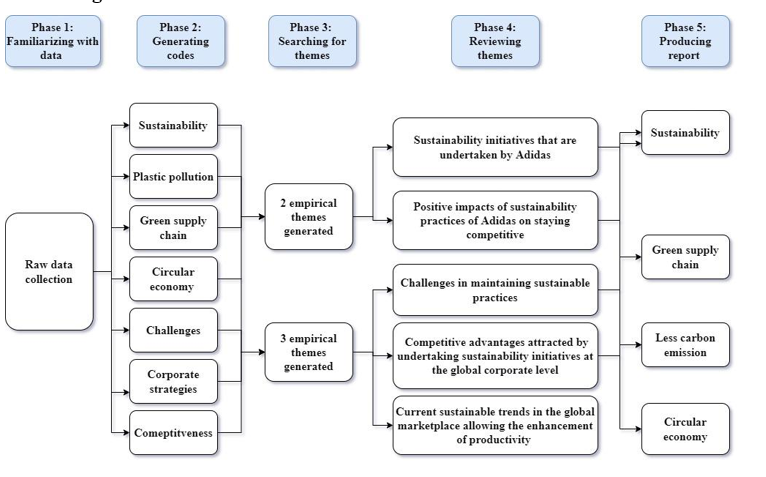
Figure 13: Coding tree
(Source: learner)
4.3 Thematic analysis
Theme 1: Sustainability initiatives undertaken by Adidas
Sustainability initiatives taken by Adidas will reduce the carbon footprint by 30% in the year of 2030. Adidas wants to influence the customer rationally so their every choice has a huge effect on the environment. As a large global company, Adidas decided to contribute to the planet and take serious action in order to support the environment (Adidas, 2021).
Adidas wants to eliminate the plastic material, which is damaging the environment and use these plastic materials for their sports products. Adidas focuses on better solutions for high performance material which has minimum environmental hazardous compounds. Adidas made a commitment to reduce the plastic waste in the environment through their innovation and partnership, this action helped the company to achieve sustainable growth in the market (Rollingstone, 2022).
Adidas launched its recycle process, which is focusing on three categories one is recycle looped, circular loop and regenerative loop. Recycle loop is mainly made from recycled material which is collected from waste such as pearly ocean plastics. Adidas makes prime green and prime blue fabrics, which are the popular fabrics in the market.
Adidas uses these fabrics to their products and to achieve sustainable growth and committing to the society that the company eliminates the virgin polyester material by the end of 2024 (Adidas, 2021). The circular loop method is used for remade purposes. This circular loop creation process ensures high performance while lowering the cost value of the making process so that it helps the generation. Regenerative loop, in this method products are made of with natural and renewable material to design the new products (gameplan, 2021).
Hence, these natural resources help to eliminate the plastic wastes from the planet. Adidas continuously developed the products so that the company remade the new products from the plastic waste and exploring the natural materials which is important for sustainable growth (Adidas, 2021). The company is collaborating with many other companies because Adidas only focuses on collective action that helps to change the planet and the consumer living standards. Adidas collaborated with the world’s largest second-hand party line named thread UP to launch a “choose to give back” resale program in North America (Adidas, 2021).
This program is designed to extend the life cycle of sports and consumer’s footwear where customers are invited to give their used products. Adidas built a creator club application where used products are resale (Adidas, 2021). The creator club members will earn rewards for exchanging their old lifestyle products and gears. The company aims to expand this online store within the early 2022 (Adidas, 2021). Hence, it can be said that the company wants to develop sustainable growth with unique ideas for achieving competition in the market.
Adidas wants to reduce the carbon footprint from the planet efficiently. The company takes every possibility of collaboration over competition with other similar industries (Ispo, 2021). The company launched its commercial product future craft which is running shoes with as low of a carbon footprint as possible. Adidas wants to manufacture the customised footwear with re-exploring materials and unique technique so that the packaging content has a very low amount of CO2 (Adidas, 2021). Hence, it can be said that the company achieved its goal of low carbon shoes without compromising the footwear’s performance.
Theme 2: Positive impacts of sustainability practices of Adidas on staying competitive
A great focus on sustainability has been benefiting Adidas in many ways such as gaining an incredible market reputation, gaining recognition as well as awards from recognised institutes, and ensuring competitive advantage (Adidas, 2022). The organisation has become a changed leader in terms of sustainability for more than 20 years (Port, 2021). This is because it is the first company, which has been able to bring eco-innovations to the current mass-market and led the industry with its first report regarding sustainability. Adidas is also a founding member of some innovative as well as game changing initiatives such as the “Fair Labor Association”, “Leather Working Group” and “Better Cotton” (Port, 2021).
The organisation has been regularly receiving positive recognitions from rating agencies, NGOs (non-governmental organisations), and different international institutes in terms of its holistic approaches in managing sustainability (Adidas, 2022). For evidence, by editing agency S&P, the company was awarded with an EST evolution score of 85, which has made it among the leading 10 companies in the entire universe of S&P Global Rating (Adidas, 2022).
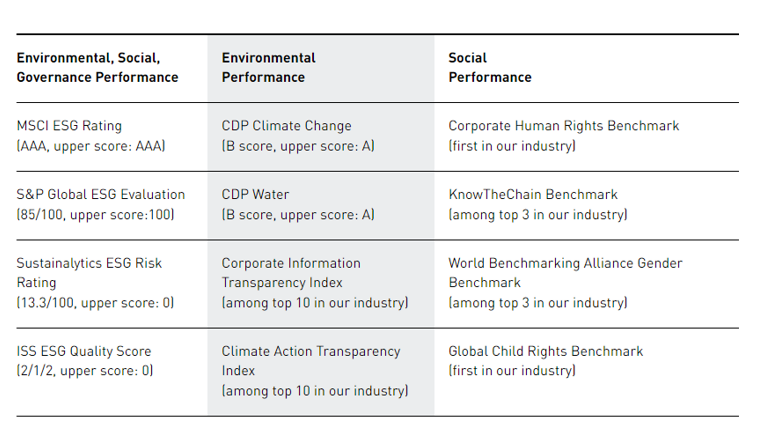
Figure 14: Performance of Adidas related to sustainability in 2021
(Source: Adidas, 2022)
Environmental sustainability is considered as one of the most important components of the business model of Adidas. In 2021, the organisation announced that it would use approximately 60% recycled polyester in its product lines such as apparel and shoe (Thomasnet, 2022). Furthermore, the organisation has been on track to reach its goal of utilising 100% recycled polyester in its manufactured products by 2024 (Thomasnet, 2022). The organisation has launched a vegan version of its Stan Smith shoe line, which has attracted customers and become a bestseller (Thomasnet, 2022).
This can be seen as evidence that the focus on sustainability has been helping the organisation to enhance its sales rate by attracting consumers with products that are manufactured by concerning the matter of sustainability. This has also been helping the organisation to stay competitive by retaining a huge number of consumers. Not only that, but the company is also working with its supply chain to reach worldwide climate naturally by the year 2050 (Thomasnet, 2022). In 2020, it reported an approximately 20% reduction in its overall water consumption at its tier 1 supplier facilities and an approximately 35% reduction at tier 2 facilities (Thomasnet, 2022). Apart from that, during the global crisis of the coronavirus pandemic, the company has taken the initiative to secure the safety as well as the well-being of its employees and suppliers.
Even the global response of the organisation to the crisis of pandemic included the distribution of 100,000 masks to medical communities at the international level and donated approximately $3.25 million to the WHO’s (World Health Organization’s) “COVID-19 Solidarity Response Fund” (Thomasnet, 2022). At the same time, Adidas also donated approximately $1.3 million to the CYDF (China Youth Development Foundation) (Thomasnet, 2022). This kind of initiative has also helped the organisation to stay competitive by gaining a huge positive recognition from not only consumers but the government of different companies, which has great importance in staying competitive.
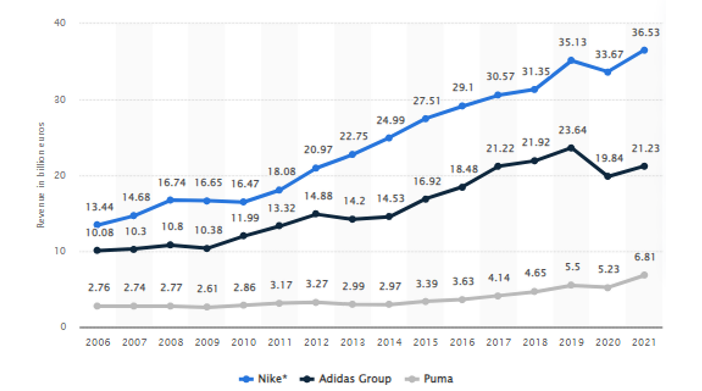
Figure 15: Worldwide revenue of Adidas and its competitors
(Source: Tighe, 2022)
The above graph is reflecting the position of Adidas in comparison with its leading competitors like Nike and Puma. As per the above graph, the company has generated approximately €21 billion in terms of revenue, in 2021, which is significantly higher than one of its leading competitors, Puma (Tighe, 2022).
This is indicating that the organisation has been able to enhance its competitive advantage. However, it is also evident that Nike is ahead of Adidas in terms of generating revenue, which made it a top competitor of Adidas (Tighe, 2022). It can be stated that behind the overall organisational growth as well as the competitive market position of Adidas its sustainable approaches have contributed to a great extent.
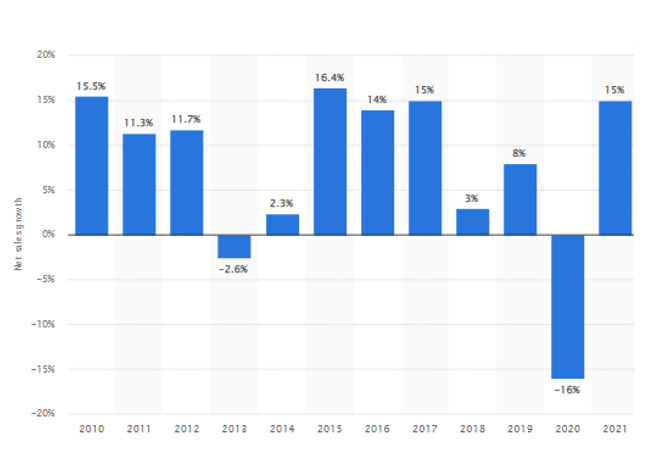
Figure 16: Adidas’s net sales growth globally from 2010 to 2021
(Source: Tighe, 2022)
In accordance with the above timeline global net sales growth of this organisation grew by approximately 15% compared to the previous year (Tighe, 2022). Furthermore, in 2021, Adidas had sales of approximately €21.23 billion (Tighe, 2022). Based on the overall analysis, it is clear that sustainable practices of Adidas have a clear positive impact on its competitive advantage.
Theme 3: Challenges in maintaining sustainable practices
The above finding has indicated the various steps Adidas has taken to achieve sustainability in the market however there are still a few challenges that the company needs to address to totally become sustainable. Following are the two major challenges that Adidas currently faces which have to some extent impacted their step towards achieving sustainability on a global scale
Challenges and issues within the Supply chain
Adidas has strategically located suppliers across the world and it also has suppliers in several Asian countries like Indonesia Cambodia India and others. As per the Clean Clothes Campaign (CCC) report Adidas has been exploiting its workers, especially in Indonesia where women have been reported to make only €86 a month which is less than the legal minimum wage (Fashion network, 2018).
Not only that as per the reports of ethical trading initiative Adidas has been blamed for not doing enough to meet the basic needs of their workers, trapping them in a cycle of poverty. As a result, Adidas has been repeatedly warned to take the necessary steps in meeting the basic needs of their workers, especially in poor Asian countries (Fashion network, 2018).
Further investigation done by CCC in Cambodia has revealed that Adidas has failed to pay 784,000 workers working across 114 factories an estimated total sum of $109 million between April-May 2021 (Yahoo Finance, 2022). Subsequently, Adidas has been blamed for wage theft previously as well that is before the pandemic when the company failed to pay an estimated total sum of $11.7 million to 30,190 workers (Yahoo Finance, 2022). These workers belong to 8 among the several supplier factories run by Adidas in Cambodia.
Apart from Cambodia, Adidas has also been blamed for unethical sourcing of cotton in China where the company has been sourcing cotton from the Xinjiang region in China where repeated cases of forced labour have been reported among the Uyghur population (Yahoo Finance, 2022). This is a major concern not only for the people working in the supply chain of Adidas but for Adidas and its plans to achieve sustainability as well.
Addressing these issues within the supply chain is a major part of achieving sustainability as per the Triple bottom line theory where ‘People’ represent one of the 3 aspects that allow companies to achieve sustainability in an ethical manner (Biswas et al. 2018). Moreover, addressing the basic needs of workers is also a clear responsibility of Adidas as per the “UNSDG 8: Promote sustained, inclusive and sustainable economic growth, full and productive employment and decent work for all” (UNSDG, (2022).
Thereby failing to meet these global standards and repeatedly being blamed for exploiting workers in the supply chain, especially in Asia is a major challenge that is not only hampering the reputation of the organisation but is also hurting its sales (Yahoo Finance, 2022). Due to the unethical procurement of cotton in China, the products of Adidas were boycotted in various Chinese markets. This led to a drop in sales and thus continuing such unethical practices could cost the company on a global scale.
Challenges in waste management
Adidas extensively focuses on waste management and some of its recent strategies that are in towards achievement of sustainability have been focused on utilising waste plastic bottles. Not only that but the organisation itself is also responsible for generating a lot of waste as a typical issue manufactured by Adidas can be recycled for approximately 30% of the materials while the rest goes to incineration or dumping grounds (Zink and Geyer, 2019). Therefore, the organisation has not been able to achieve 100% recyclable capability and this has been acting against the company’s claim of being sustainable in the industry.
Apart from that, the company is mostly focused on recycling plastic rather than its own products to achieve a circular economy. However, recycling plastic has often been identified to be a process that not only introduces more plastic to the system but is also not profitable in the long run. One of the major difficulties of recycling plastics is the quality of plastic that degrades every time it is recycled (Abbasi, 2018). As a result, to ensure optimum quality new virgin plastic is introduced to the product.
It has also been studied that only 9% of all the plastic that is currently circulating around the world can be recycled and the rest of the 91% of plastic becomes so inferior quality that they cannot be used for manufacturing products and the only way to get rid of them is through landfills or incineration (Plastic soup foundation, 2022). Both these alternatives for the rest of the 91% of plastic are not good for the environment as this pollutes the soil quality as well as leads to a lot of pollution.
Adidas’s approach of utilising as a mean raw material for their shoes still has a substantial number of flaws as it collects plastic bottles instead of their own shoes for recycling (Input mag, 2022). Studies suggest recycling plastic is a myth and it only apps as a process of introducing more plastic into the system therefore this cannot be identified as a solution to encounter plastic waste (The Guardian, 2019). However, this process of recycling can slow down the introduction of virgin plastic into the system nevertheless this is not going to resolve the increase in the amount of plastic waste that is leading to global pollution and emissions.
When it comes to Adidas where the company claims that some of their new product segments utilise recycled waste plastic is also a matter of question. Considering the fact that when these shoes would be recycled a substantial proportion of the salvaged material would not be able to make it back to the circular economy (Arangdad et al. 2019).
Therefore, at present, the sustainability efforts made by Adidas are truly appreciable however it is not sustainable and therefore the improvements that can be made to enhance the overall capacity of the system to minimise the use of plastic. The company make use of CSR strategies in order to encourage customers to minimise the use of plastic or buy fewer products which would lead to the introduction of fewer plastics which would be a similar strategy that Nike has been using (Achabou, 2020).
Theme 4: Competitive advantages attracted by undertaking sustainability initiatives at the global corporate level
Global corporations in the athletic and sports lifestyle goods industry have been providing a great focus on enhancing their competitive advantages by undertaking sustainability initiatives. Even in terms of maintaining sustainability, a clear rivalry is noted between Nike and Adidas, who are leading giants in this industry (Sharpes, 2021).
For example, Adidas has taken sustainability approaches that include recycling polyester and aiming to reduce its carbon footprint by approximately 30% by 2030 (Sharpes, 2021). While, on the other hand, Nike also determined to reduce its greenhouse gas emission by approximately 30% by the same year (Sharpes, 2021).
This comparison is reflecting a clear rivalry among global corporations in terms of achieving competitive advantages by taking sustainability related approaches. During the period of the coronavirus pandemic, the majority of players in the sports and apparel industry have noted to be focused on the aspect of sustainability in order to attract customers, as it is one of the most significant components for staying competitive in the market (Becker et al. 2022).
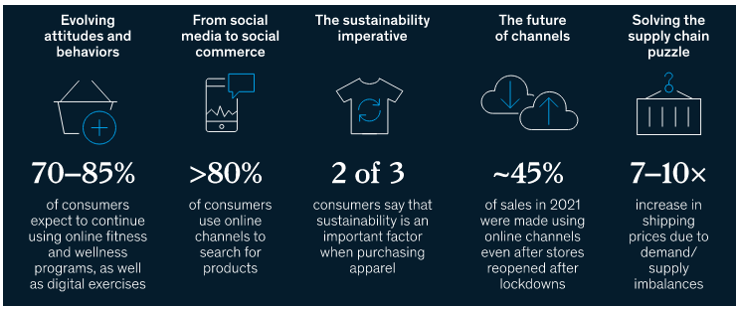
Figure 17: Key trends in shaping the sports goods industry currently
(Source: Becker et al. 2022)
Current key trends that are shaping the sporting goods industry include evolving behaviours as well as the attitude of consumers regarding sustainability, social media to social commerce, sustainability imperative, and solving supply chain related puzzles. In this regard, it has been found that approximately 72% to 85% of customers worldwide are expecting to continue utilising online fitness and wellness programs, which is indicating consumers changed behaviour after the pandemic in keeping their health better (Becker et al. 2022).
Furthermore, every 2 of 3 customers worldwide are saying that sustainability is the most important factor that they are considering when they are purchasing any kind of apparel product (Becker et al. 2022). This is indicating the reason why companies in the industry have been providing a great focus on undertaking sustainable approaches to satisfy consumers.
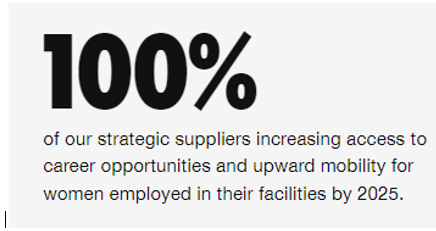
Figure 18: Nike’s focus on wellbeing of women employees
(Source: Nike, 2022)
Apart from that, leading global corporations in this specific industry have also been taking sustainable approaches for impacting the world and environment positively, which is also beneficial for gaining competitive advantages. For example, Nike has been noted to take a multi-faceted approach, which has a great impact on enhancing its competitiveness.
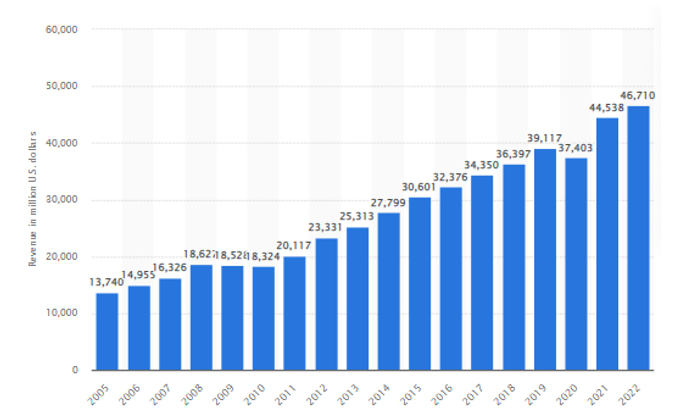
Figure 19: Nike’s global revenue from 2005 to 2022
(Source: Tighe, 2022)
The organisation has joined the UN Climate Change, and worldwide companies, suppliers, and retailers of the industry to achieve climate targets, which is a great initiative (Sharpes, 2021). Furthermore, 100% of suppliers of Nike increased access in terms of career opportunities as well as upward mobility for women employed by 2025 (Nike, 2022).
It is evident that Nike has been able to be ahead of leading market players in this industry such as Adidas and Puma in terms of generating revenue as well as a competitive advantage (Tighe, 2022). For evidence, the global revenue of this organisation in 2022, amounted to approximately $46.71 billion, which is approximately a $2 billion increase in a comparison with the previous year (Tighe, 2022). Behind this growth of Nike, its focus on sustainability has been playing a significant role.
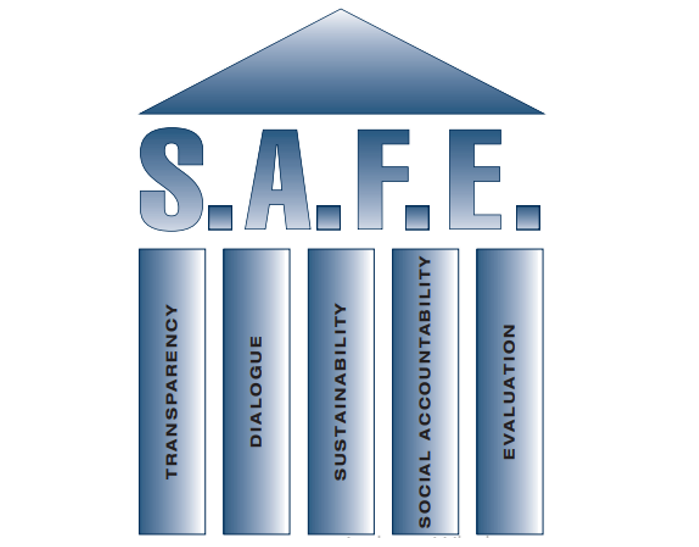
Figure 20: Puma’s principles of social and environmental policies
(Source: Puma, 2022)
Another leading global corporation in the sports shoe and apparel industry is Puma, which also believes in integrating sustainability into almost every aspect of its manufacturing process (Puma, 2022). The organisation is aiming to reduce approximately 35% of its greenhouse gas emissions by the year 2030 and the target was approved by the SBTi (Science Based Target initiative) (Puma, 2022). Based on the real business evidence of companies from the sports shoes and apparel industry, it is clear that sustainable initiatives have become a key to achieve competitive advantages for companies that are operating their business on a global corporate level.
Theme 5: Current sustainable trends in the global marketplace allowing enhancement of productivity
Sustainability has become the current trend in the global marketplace because of its high efficiency in improving the business structure as well as its brand value. Not only organisations but consumers are also focusing on sustainable practices and initiatives, which is helping the environment to drive better. It has been investigated that, about 20 to 50 million metric tons of electronic waste is being produced, which has helped in 11.4% of the recovery for recycling along with saving 9 gallons of oil (Eco Friendly Habits, 2022).
Apart from this, 14% of consumers are trying to change their consumption habits so that the environment can be saved (Eco Friendly Habits, 2022). Moreover, consumers have highly spent about $128.5 billion on sustainable Fast Moving Consumer Goods (FMCG) products in the year 2018 (Eco Friendly Habits, 2022). From the statistics, it can be understood that consumers are the ones who are driving toward the enhancement of sustainable trends in the global marketplace, which has extensively forced the business organisation to take sustainable practices.
Moreover, while investigating it has been identified that the current sustainable trends that are taking the versatile world of discussing net zero emission, climate change along with managing the waste effectively are the primary focus (Swallow, 2022).
The trends basically include all hybrid working setups, carbon offsetting net-zero emission, green penalty for lack of climate action, electronic infrastructure, sustainable product, investment of environmental social and government (ESG) and many others (Swallow, 2022). The focus on ESG investment has increased from $236 billion in 2022 to $357 billion during the year 2021 (SustainFi, 2022). As suggested in the figure below it can be stated that it has reached a 51% growth rate in between 2020 to 2021 respectively (SustainFi, 2022).
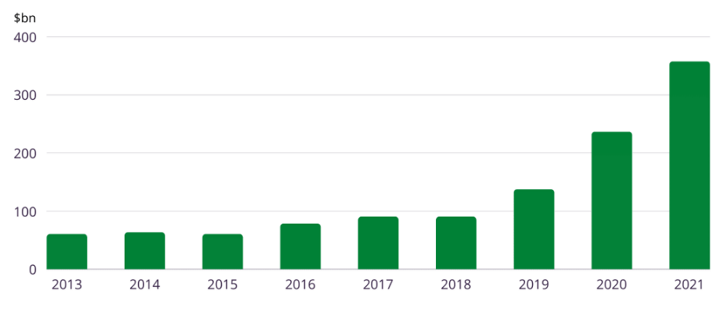
Figure 21: ESG fund gain
(Source: SustainFi, 2022)
In terms of hybrid-working sustainable initiatives, Puma, one of the greatest organisations in the footwear industry, is offering flexibility to their staff while restructuring their organisational structure (Reuters, 2021). Improvement of flexible working with hybrid working aspects, which has been influenced by COVID-19 are taken as a sustainable initiative at Puma. In relation to this, the president of Puma has stated “We are pretty bullish on the opportunity here in North America and we feel like we have emerged stronger through difficult times” (Reuters, 2021). Due to these practices while maintaining the CSR of the company the sales of Puma has increased 31% in the 3Q while accounting 37% with total even during pandemic (Reuters, 2021).
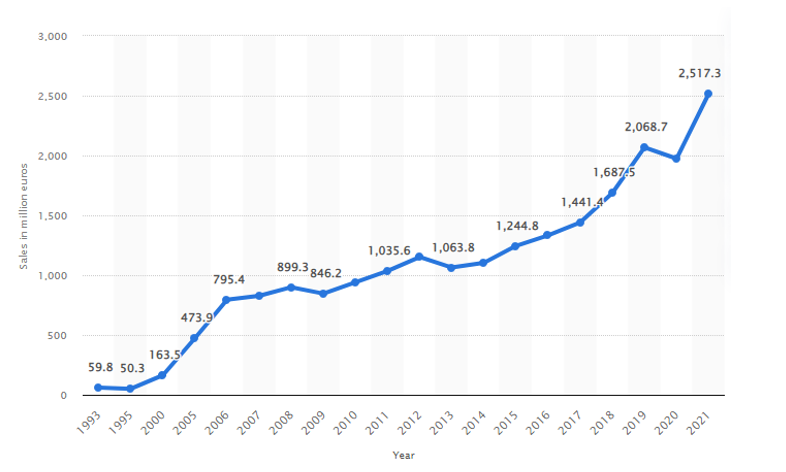
Figure 22: Puma sales are increasing
(Source: Tighe, 2022)
Moreover, concerning another example of an organisation such as Nike who are also focusing on presenting a zero carbon and zero waste initiative towards their project of climate change. It has been identified that across the globe the number of days after the 1980s are increasing to 90°F with 25% (Nike, 2019). Therefore, with being committed towards sustainable initiative and practising Nike’s global design community nikecirculardesign.com is an effort to take sustainable initiatives, which has diverted 6.4 billion plastic bottles, as well as length, fills positively (Nike, 2019).
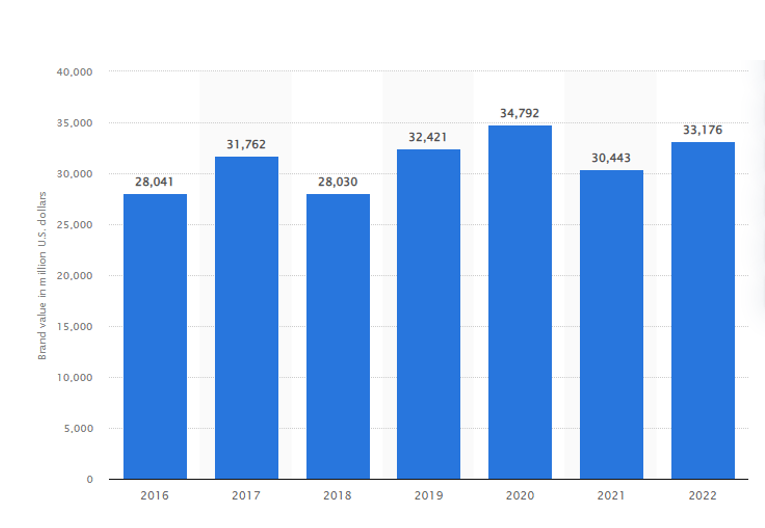
Figure 23: Increased brand value of Nike
(Source: Tighe, 2022)
Due to extensive imposition towards sustainable practices and initiatives, the brand value of Nike is continuously increasing. It has been noticed that Nike’s market is valued much more over $33 billion in 2022, which is an almost $3 billion increase over the preceding season as suggested in the above figure (Tighe, 2022) Moreover, concerning Adidas it has been determined that Adidas has set-up a transformation with digitalisation while aiming €4 billion from e-commerce (InfoTechLead, 2019). Moreover, Adidas is using a consumer facing digital ecosystem, which is helping their digital transformation with more infrastructure development with sustainability.
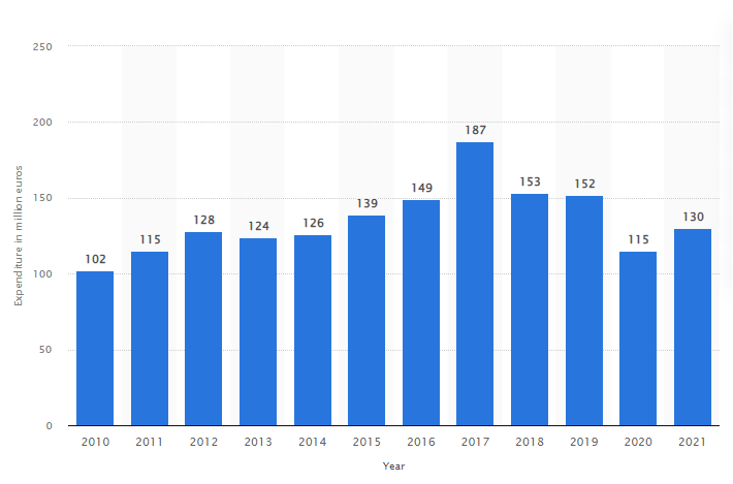
Figure 24: Research and development expenditure of Adidas
(Source: Tighe, 2022)
Apart from this, Adidas has also saved 35% of infrastructure expenses with the support of Oracle Cloud (Suneratech, 2022). Furthermore, Adidas invested around €130 million in 2021 in research and development, which is supporting their sustainable practices with digitalisation (Tighe, 2022). Hence, it can be stated that there have been numerous sustainable trends in the global marketplace, which are enhancing business productivity and their competitive advantages respectively.
4.4 Discussion
The overall analysis of collected data regarding sustainable approaches of Adidas, reflects that the organisation is considering sustainability as one of the most significant aspects of its business. The organisation has taken the initiative to eliminate the use of plastic material, in order to reduce its overall carbon footprint. Moreover, the initiative of Adidas to focus on aspects such as recycling and reusing also has a separate significance in terms of contributing in the sustainable development of this organisation (Adidas, 2021).
Additionally, by utilising the level “made to be remember” the company creates products that are completely designed with circularity in mind. The products of Adidas utilise the materials that can be returned to the system of recycling at the end of product lives (Adidas, 2022). In this regard, the initiative of Adidas to collect used products from customers and recycle them in manufacturing new products also has a great contribution in enhancing the sustainable approaches of the organisation (Adidas, 2022).
The great focus on sustainability, has been assisting the organisation in not only improving its performance but also in enhancing its competitive advantage. It can be easily noted that Adidas has been able to gain a huge market reputation, in which its focus on sustainability has played the most crucial role. Even with the effective focus on adopting sustainable approaches the company has become one of the most valuable companies that are integrating sustainable approaches worldwide (Port, 2021).
On the other hand, the recognition of Adidas has also increased significantly because of its founding membership of game changing initiatives such as “Leather Working Group” and “Better Cotton,” which have a great contribution in enhancing its reputation as well as the market position (Port, 2021).
This further influences the overall competitive advantage of the organisation significantly. It is evident that because of effective initiatives to be completely sustainable the organisation has received several awards, which has also increased its recognition as a global corporation that has concerns regarding sustainability (Adidas, 2022). A significant growth is noted in the global sales of Adidas in 2021 (Tighe, 2022). Behind this, sustainable approaches of this organisation have contributed to some extent.
This is because consumers nowadays are more willing to make purchases from an organisation that has a great focus on sustainability and impacts the world as well as the environment in a positive manner (White et al. 2019). Adidas has been able to be ahead of its rivals such as Puma, in terms of generating revenue (Tighe, 2022). However, the organisation needs to be more active to enhance its competitive advantage as Nike beats the organisation in terms of generating revenue (Tighe, 2022).
The above analysis also reflects that not only Adidas but also global corporations such as Nike and Puma have also been focusing on sustainability. In terms of reducing carbon footprint, Nike has also taken initiatives to recycle products in order to achieve its zero-carbon emission rate (Nike, 2022).
In this regard, it is also noted that the effective focus on taking sustainable approaches has been contributing in enhancing the market position of Nike to a great extent. In terms of revenue, Nike is ahead of Puma and Adidas as well. The current revenue of Nike is approximately $46.71 billion, which is a significant hike from its previous year (Tighe, 2022).
Another global corporation from the sports shoe and apparel industry, Puma is also noted to have a great focus on sustainable development (Puma, 2022). By evaluating the market position of leading global corporations in this specific industry and the contribution of their sustainability initiative in this regard, it is clear that they are staying competitive in the current marketplace.
The study has also helped in identifying some of the major challenges that Adidas is currently facing within its supply chain where issues linked with wages paid to workers have been identified. The company has paid significantly fewer wages to the workers which has attracted various international critics against Adidas and its policies.
There have also been lawsuits where the company has been accused of wage theft and this is a major issue. This has not only hampered the reputation of the organisation but has also led to losses as products of Adidas have been boycotted in China for anything sourcing of cotton. Adding to that the study also reflects how the sustainable practices of Adidas that aims to minimise the use of plastic are slowly introducing more plastic to the system and recycling is not as sustainable as it appears to be.
It has been identified that there are significant sustainable trends going on in the global marketplace, which is allowing the enhancement of business productivity and competitive advantage.
It has been noted that maximum consumers are now being extremely reliant on sustainable practices, as it has been identified that 14% of consumers are moving their consumer habits as per the requirements of saving the environment (Eco Friendly Habits, 2022). Moreover, $128.5 billion consumers are spending on FMCG products in terms of improving eco-friendly habits (Eco Friendly Habits, 2022). Nevertheless, several trends of sustainability measurements such as measuring climate change, managing waste, net zero emission, focusing on hybrid working set up and many others existed.
In connection to that, there has been extensively high investment on ESG with $375 billion in 2021, which has attained growth of 51% (SustainFi, 2022). It can be noted that, organisations such as Puma, Nike and Adidas have sustainable initiatives in their organisation while supporting flexible working, reducing the use of plastic, committing to sustainable nature along with high improvement of undertaking digital growth. Hence, from this discussion it can be stated that the maximum number of businesses that are having extremely positive sustainable change and initiatives are heavily improving their business performance and productivity.
4.5 Summary
Based on the overall findings and analysis of this chapter, it is clear that global corporations have been providing significant attention in taking sustainable approaches, as it is strongly related to sustainability.
Moreover, companies such as Adidas, Puma, and Nike have been taking effective sustainable approaches like reusing polyester and decreasing carbon emission rate, which is helping them to impact the environment as well as the overall world positively. By analysing sustainability approaches undertaken by Adidas, it can clearly be summarised, that these approaches of the organisation have great relevance in terms of enhancing its competitive advantages.
The example of other global companies that are also based in the sports and apparel industry also reflects a clear focus on sustainability while their aim to achieve competitive advantage and be sustainable in the global marketplace. Hence, it is clear that global corporations have been enhancing their focus on sustainability, as it is considered a path to success.
Chapter 5: Conclusion and Recommendation
5.1 Summary
The overall findings and analysis of the current research are strongly indicating that global corporations have been providing a great focus in adopting sustainable practices in order to stay competitive.
Moreover, the evaluation of sustainable practices adopted by Adidas has made it clear that they are taking part in enhancing the organisational reputation of Adidas and accelerating its overall growth. In other words, a great focus on reducing the negative impact of business activities on the environment and the planet has been helping Adidas to enhance its competitive advantage significantly.
Even the competitors of Adidas such as Puma and Nike are also found to take initiative regarding sustainable development, as they also considered this aspect as a path for being competitive in the marketplace. This is because consumers worldwide nowadays are more concerned about sustainability and they are willing to be connected with companies that are considering this aspect significantly in their business operational activities.
Apart from that, trends that are related to sustainability such as achieving zero carbon emission rate, investing in ESG, and adopting hybrid working culture by considering the factor of the well-being of workers, also have great relevance in terms of achieving competitive advantage by global corporations. This is because mentioned trends are strongly related to the sustainable development of an organisation. Hence, global corporations such as Adidas and others have been providing importance to current market trends that are related to sustainability.
From this, it is clear that the aspect of sustainability has great relevance on enhancing the customer base and revenue generation of global corporations. From the analysis of the current market position of Adidas and Nike, significant growth is noted in terms of generating revenue, which is indicating their notable competitive advantage. Hence, it can be concluded that sustainability initiatives of global corporations are helping them to stay competitive in the global marketplace.
5.2 Linking with objectives
Significance of sustainable practices in global corporations for attracting competitive advantages
The first objective is specified to measure the significance of sustainable practices at the global corporation along with attracting competitive advantages. This objective has been specifically formed based on the research topic so that the purpose of the investigation can get mitigated. In this connection, several arguments of authors and statistics from different sources are being collected to address this research objective positively.
While working on this objective, it has been identified that sustainable practices are extensively growing in the marketplace due to which its prevalence among the business organisations are also improving. Through this, businesses are able to improve their goods and services along with minimising environmental impact. These findings linked with the significance of sustainability and its practices among global corporations like Adidas for achieving competitive advantage has helped in achieving the subject.
Challenges that are being faced by Adidas in maintaining a sustainable approach in their organisation
The second objective is about the challenges that are being faced by Adidas while maintaining sustainable approaches in the organisation. Both literature review and data analysis have addressed this objective while reflecting on issues such as production waste, water supply concerns, and others. Apart from this, organisational cultural issues with values and beliefs are the ones Adidas is facing issues in terms of sustainable development. Moreover, the supply chain has also been identified to be one of the core aspects of imposing challenges.
The study has identified that the company is facing severe sustainability issues regarding the payment of wages in various Asian countries and has been accused of wage theft. The data analysis has also held in understanding how the recycling strategy of Adidas still has a few flowers present in it that needs to be rectified in order for it to become totally sustainable. These aspects and challenges that have been discussed and analysed in the above study have helped in achieving this objective.
Advantages that can be attained through the help of sustainable initiatives in global corporations
The third and final objectives reflect the advantages that can be attained by sustainable initiatives in global corporations. Referring to this, it has been identified that there are numerous potential benefits such as improved brand value, increased encouragement among employees, increasing environmentally sensitive approaches along with positive organisational profitability.
These advantages have been embraced during addressing this objective. Apart from this, it has been identified that Adidas is targeting specified sustainable practices along with investing in ESG performance positively. These advantages that have been listed analyse and critically evaluated regarding the sustainable initiative adopted by Adidas have helped in addressing this objective
5.3 Recommendations
Adidas should take the important initiative to decrease carbon emission. For instance, one sustainable solution is dry dye technology which does not require water and uses less than 50% of energy and less chemicals when it is prepared compared to any other conventional dying process. It has won the best award as a product of high ecological and sustainable values. Adidas should not only make footwear and sports goods but also the company can approach a sustainable manufacturing process by its innovation teams.
Management team of Adidas should take different innovative actions which give sustainable growth in the market. The management leader should provide different training programmes to employees which is helpful for increasing employee productivity. Adidas should focus on sustainable fibres such as recycled polyester which is used with water saving dyeing technologies.
The company leaders can search for the best technologies and explore the company’s affordability. Management team of Adidas should be committed to implant sustainability in all of the company’s products. Adidas should focus on the four verticals of sustainability which are people, product, planet, and partnership. So that the employees of the company are working well for the society. These four pillars provide a strategic framework that empower Adidas stakeholders including 50000 employees, customer, supplier, and community so that the company easily accesses and evaluates the group sustainability efficiency.
Through different stakeholders and partnership collaboration Adidas’s group members will definitely achieve sustainability goals and achievements such as increasing use of waste plastic materials in its product making. This advanced product making technology allows the company to use around 1.5 million waste materials. Hence, it can be said that in this process Adidas can reduce its carbon footprint and make a clean planet. Adidas management team can provide energy management training and can share its sustainable strategies to employees.
Adidas should invest in the carbon reduction project which is helpful for employees to realise the company’s future goals and objectives. Adidas should set the company’s goals to that extent that it will require further innovation over the upcoming years. The companies should only focus on using more renewable and waste raw material and processing these materials on a large scale. Adidas can use such unconventional materials like biobased synthetics, and more natural materials which are sustainably grown. Using these materials on a small scale so that it will become progressively appropriate in the future. Those innovations will bring the company closer to a circular economy which does not compromise the product’s performance.
According to United Nation research the species extinction rates are increasing and the decline of biodiversity is unparalleled. As the fashion and sports brand Adidas must support the development structure which is based on science and targets to save the environment for humans. Committing to these targets Adidas should take serious implementation for saving biodiversity which is a new industrial trendy style within the fashion industry.
This awareness makes huge impacts on biological diversity. Adidas should influence the customers to realise the company’s sustainable plan so that customers can buy more recyclable products. Considering these customer’s decision-making process and target setting process can lead to a significant change in the environment.
The matter of sustainability has a separate significance in the current business environment as it is strongly related to business success. The current research is focused on sustainable approaches taken by global corporations in order to be competitive in the marketplace, which has a great scope to be utilised in the future by organisational managers.
This is because organisational managers can enhance their knowledge regarding the significance of taking sustainable approaches while operating business in the global market. Moreover, organisational managers can also get proper knowledge regarding sustainable trends that can help them to enhance competitive advantage. Apart from that, this also has a great scope to be utilised by students in the future who would research in the same context, as the research includes relevant information regarding the context.
Additionally, the research also has a scope to be utilised as sample research by educational institutes, as it is completed by following proper research methodologies and maintaining a proper structure.
References
Abbasi, S.A., (2018). The myth and the reality of energy recovery from municipal solid waste. Energy, Sustainability and Society, 8(1), pp.1-15.
Abd Rahman, N.M., Lim, C.H. and Fazlizan, A., (2021). Optimizing the energy saving potential of public hospital through a systematic approach for green building certification in Malaysia. Journal of Building Engineering, 43, p.103088.
Aboelmaged, M. and Hashem, G., (2019). Absorptive capacity and green innovation adoption in SMEs: The mediating effects of sustainable organisational capabilities. Journal of cleaner production, 220, pp.853-863.
Achabou, M.A., (2020). The effect of perceived CSR effort on consumer brand preference in the clothing and footwear sector. European Business Review, 32(2), pp.317-347.
Adidas, (2021). ENVIRONMENTAL IMPACTS. [Online]. Available at: <https://report.adidas-group.com/2021/en/group-management-report-our-company/sustainability/environmental-impacts.html> [Accessed 03 August 2022]
Adidas, (2021). Our sustainable initiatives. [Online]. Available at: <https://report.adidas-group.com/2021/en/at-a-glance/2021-stories/our-sustainability-initiatives.html> [Accessed on 26 August 2022]
Adidas, (2022). MORE SUSTAINABLE MATERIALS AND CIRCULAR SERVICES. [Online]. Available at: <https://www.adidas-group.com/en/sustainability/environmental-impacts/more-sustainable-materials-and-circular-services/> [Accessed 28 August 2022]
Adidas, (2022). RECOGNITION AND HISTORY. [Online]. Available at: <https://www.adidas-group.com/en/sustainability/focus-sustainability/recognition-history/> [Accessed 28 August 2022]
Alharahsheh, H.H. and Pius, A., (2020). A review of key paradigms: Positivism VS interpretivism. Global Academic Journal of Humanities and Social Sciences, 2(3), pp.39-43.
Ali, I. and Davis-Floyd, R., (2022). Global Negotiations Around COVID-19. Negotiating the Pandemic, p.312.
Anwar, G. and Abdullah, N.N., (2021). The impact of Human resource management practice on Organizational performance. International journal of Engineering, Business and Management (IJEBM), 5.
Arangdad, S.R., Thoney-Barletta, K., Joines, J. and Rothenberg, L., (2019). Influence of demographics and motivational factors on US consumer clothing and shoes disposal behavior. Research Journal of Textile and Apparel.
Asabuwa Ngwabebhoh, F., Saha, N., Saha, T. and Saha, P., (2021). Bio-innovation of new-generation nonwoven natural fibrous materials for the footwear industry: Current state-of-the-art and sustainability panorama. Journal of Natural Fibers, pp.1-11.
Asenahabi, B.M., (2019). Basics of research design: A guide to selecting appropriate research design. International Journal of Contemporary Applied Researches, 6(5), pp.76-89.
Ashrafi, M., Adams, M., Walker, T.R. and Magnan, G., (2018). How corporate social responsibility can be integrated into corporate sustainability: A theoretical review of their relationships. International Journal of Sustainable Development & World Ecology, 25(8), pp.672-682.
Atmowardoyo, H., (2018). Research methods in TEFL studies: Descriptive research, case study, error analysis, and R & D. Journal of Language Teaching and Research, 9(1), pp.197-204.
Baldassarre, B., Keskin, D., Diehl, J.C., Bocken, N. and Calabretta, G., (2020). Implementing sustainable design theory in business practice: A call to action. Journal of cleaner production, 273, p.123113.
Barreiro‐Gen, M. and Lozano, R., (2020). How circular is the circular economy? Analysing the implementation of circular economy in organisations. Business Strategy and the Environment, 29(8), pp.3484-3494.
Becker, S., Berg, A., Kohli, S., and Thiel, A., (2022). Sporting goods 2022: The new normal is here. [Online]. Available at: <https://www.mckinsey.com/industries/retail/our-insights/sporting-goods-2022-the-new-normal-is-here> [Accessed 28 August 2022]
Biswas, I., Raj, A. and Srivastava, S.K., (2018). Supply chain channel coordination with triple bottom line approach. Transportation Research Part E: Logistics and Transportation Review, 115, pp.213-226.
Boakye, D.J., TIngbani, I., Ahinful, G., Damoah, I. and Tauringana, V., (2020). Sustainable environmental practices and financial performance: Evidence from listed small and medium‐sized enterprise in the United Kingdom. Business Strategy and the Environment, 29(6), pp.2583-2602.
Bolander, W., Chaker, N.N., Pappas, A. and Bradbury, D.R., (2021). Operationalizing salesperson performance with secondary data: aligning practice, scholarship, and theory. Journal of the Academy of Marketing Science, 49(3), pp.462-481.
Brantnell, A. and Baraldi, E., (2020). Following unique logics despite institutional complexity: An inductive study of academic inventors and institutional logics. European Management Journal, 38(5), pp.684-697.
Camilleri, M.A., (2022). Strategic attributions of corporate social responsibility and environmental management: The business case for doing well by doing good!. Sustainable Development, 30(3), pp.409-422.
Cantele, S. and Zardini, A., (2018). Is sustainability a competitive advantage for small businesses? An empirical analysis of possible mediators in the sustainability–financial performance relationship. Journal of cleaner production, 182, pp.166-176.
Christie, 2021. Sustainable Shoes: A Complete Guide and 30 Ethical Brands. [Online]. Available at: <https://www.unsustainablemagazine.com/a-guide-to-ethical-and-sustainable-footwear-brands/> [Accessed 03 August 2022]
Crespi-Abril, A.C. and Rubilar, T., (2021). Moving forward in the ethical consideration of invertebrates in experimentation: Beyond the Three R’s Principle. Revista de Biología Tropical, 69, pp.346-357.
Danziger, P.N. (2019). Adidas Challenges The Fashion Industry In Sustainability, Pledging Only Recycled Plastic By 2024. [Online]. Available at: <https://www.forbes.com/sites/pamdanziger/2019/07/18/adidas-challenges-the-fashion-industry-in-sustainability-pledging-only-recycled–plastic-by-2024/?sh=5ef9179d1049> [Accessed 03 August 2022]
Das, J.N., Tiwari, M.K., Sinha, A.K. and Khanzode, V., (2022). Integrated warehouse assignment and carton configuration optimization using deep clustering-based evolutionary algorithms. Expert Systems with Applications, p.118680.
Denga, E.M., Vajjhala, N.R. and Rakshit, S., (2022). Relationship Selling as a Strategic Weapon for Sustainable Performance. In Sales Management for Improved Organizational Competitiveness and Performance (pp. 78-101). IGI Global.
Eco Friendly Habits, (2022). 47 Eco Friendly Stats That Will Blow Your Mind. [Online]. Available at: <https://www.ecofriendlyhabits.com/eco-friendly-stats/> [Accessed 28 August 2022]
Fashion network, (2018). Adidas, Nike urged to ensure fair wages for Asian workers making World Cup kits. [Online]. Available at https://ww.fashionnetwork.com/news/adidas-nike-urged-to-ensure-fair-wages-for-asian-workers-making-world-cup-kits,986508.html [Accessed 28 August 2022]
Fiesler, C., Friske, M., Garrett, N., Muzny, F., Smith, J.J. and Zietz, J., (2021), March. Integrating Ethics into Introductory Programming Classes. In Proceedings of the 52nd ACM Technical Symposium on Computer Science Education (pp. 1027-1033).
Furstenau, L.B., Sott, M.K., Kipper, L.M., Machado, E.L., Lopez-Robles, J.R., Dohan, M.S., Cobo, M.J., Zahid, A., Abbasi, Q.H. and Imran, M.A., (2020). Link between sustainability and industry 4.0: trends, challenges and new perspectives. Ieee Access, 8, pp.140079-140096.
Gameplan, (2021). THE ADIDAS SUSTAINABILITY STORY – LEADING THE CHANGE. [Online]. Available at: <https://www.gameplan-a.com/2021/12/the-adidas-sustainability-story-leading-the-change/> [Accessed on 26 August 2022]
Ganda, F., (2019). The impact of innovation and technology investments on carbon emissions in selected organisation for economic Co-operation and development countries. Journal of cleaner production, 217, pp.469-483.
Gatley, J., (2020). Philosophy for children and the extrinsic value of academic philosophy. Metaphilosophy, 51(4), pp.548-563.
Goralski, M.A. and Tan, T.K., (2020). Artificial intelligence and sustainable development. The International Journal of Management Education, 18(1), p.100330.
Gov, (2022). Copyright, Designs and Patents Act 1988. [Online]. Available at: <https://www.legislation.gov.uk/ukpga/1988/48/contents> [Accessed 27 August 2022]
Gov, (2022). Data Protection Act 2018. [Online]. Available at: <https://www.legislation.gov.uk/ukpga/2018/12/contents/enacted> [Accessed 27 August 2022]
Grover, R., Emmitt, S. and Copping, A., (2019). A representational framework for sustainable design. WIT Transactions on The Built Environment, 183, pp.61-72.
Haseeb, M., Hussain, H.I., Kot, S., Androniceanu, A. and Jermsittiparsert, K., (2019). Role of social and technological challenges in achieving a sustainable competitive advantage and sustainable business performance. Sustainability, 11(14), p.3811.
ICO, (2022). The principles. [Online]. Available at: <https://ico.org.uk/for-organisations/guide-to-data-protection/guide-to-the-general-data-protection-regulation-gdpr/principles/> [Accessed 27 August 2022]
Ikram, M. and Kenayathulla, H.B., (2022). Out of Touch: Comparing and Contrasting Positivism and Interpretivism in Social Science. Asian Journal of Research in Education and Social Sciences, 4(2), pp.39-49.
InfoTechLead, (2019). Adidas steps up digital transformation aiming €4 bn from e-commerce. [Online]. Available at: <https://infotechlead.com/cio/adidas-steps-up-digital-transformation-aiming-e4-bn-from-e-commerce-58504> [Accessed 28 August 2022]
Input mag, (2022). Can sneakers ever really be sustainable? “Buy, buy, buy is going to kill us all.”. [Online]. Available at https://www.inputmag.com/style/nike-space-hippie-adidas-parley-recycled-sneakers-sustainability [Accessed 28 August 2022]
Islam, A.H., Sarker, M.R., Hossain, M.I., Ali, K. and Noor, K.A., (2021). Challenges of Small-and Medium-Sized Enterprises (SMEs) in business growth: A case of footwear industry. Journal of Operations and Strategic Planning, 4(1), pp.119-143.
Ispo, (2021). Climate neutral by 2050: This is Adidas’ sustainability plan. [Online]. Available at: <https://www.ispo.com/en/companies/adidas-sustainability-plan-climate-neutral-2050> [Accessed on 26 August 2022]
Kakadellis, S. and Harris, Z.M., (2020). Don’t scrap the waste: The need for broader system boundaries in bioplastic food packaging life-cycle assessment–A critical review. Journal of Cleaner Production, 274, p.122831.
Keung, E.Z., McElroy, L.M., Ladner, D.P. and Grubbs, E.G., (2020). Defining the study cohort: inclusion and exclusion criteria. In Clinical Trials (pp. 47-58). Springer, Cham.
Khan, S.A.R., (2019). The nexus between carbon emissions, poverty, economic growth, and logistics operations-empirical evidence from southeast Asian countries. Environmental Science and Pollution Research, 26(13), pp.13210-13220.
Kilu, R.H. and Sanda, M.A., (2020), July. Green Work Environments and Workforce Productivity Among Energy Organizations in Ghana. In International Conference on Applied Human Factors and Ergonomics (pp. 163-170). Springer, Cham.
Koltay, T., (2019). Accepted and emerging roles of academic libraries in supporting research 2.0. The Journal of Academic Librarianship, 45(2), pp.75-80.
Lahti, T., Wincent, J. and Parida, V., (2018). A definition and theoretical review of the circular economy, value creation, and sustainable business models: where are we now and where should research move in the future?. Sustainability, 10(8), p.2799.
Lainson, K., Braun, V. and Clarke, V., (2019). Being both narrative practitioner and academic researcher: A reflection on what thematic analysis has to offer narratively informed research. International Journal of Narrative Therapy & Community Work, (4), pp.86-98.
López‐Concepción, A., Gil‐Lacruz, A.I. and Saz‐Gil, I., (2022). Stakeholder engagement, Csr development and Sdgs compliance: A systematic review from 2015 to 2021. Corporate Social Responsibility and Environmental Management, 29(1), pp.19-31.
Mahmud, A., Ding, D. and Hasan, M.M., (2021). Corporate social responsibility: Business responses to Coronavirus (COVID-19) pandemic. SAGE open, 11(1), p.2158244020988710.
Manavalan, E. and Jayakrishna, K., (2019). An analysis on sustainable supply chain for circular economy. Procedia Manufacturing, 33, pp.477-484.
Martins, V.W.B., Rampasso, I.S., Anholon, R., Quelhas, O.L.G. and Leal Filho, W., (2019). Knowledge management in the context of sustainability: Literature review and opportunities for future research. Journal of cleaner production, 229, pp.489-500.
Mazotto, A.M., (2022). Biopolymers in the Leather Industry. In Biopolymers (pp. 245-270). Springer, Cham.
McKinsey, (2022). The business of sustainability. [Online]. Available at: <https://www.mckinsey.com/business-functions/sustainability/our-insights/the-business-of-sustainability-mckinsey-global-survey-results> [Accessed 03 August 2022]
McLoughlin, D. (2021). All Eco Sneakers Do Is Kill The Planet a Little Bit Slower [Study]. [Online]. Available at: <https://runrepeat.com/eco-sneakers-research> [Accessed 03 August 2022]
Melnikovas, A., (2018). Towards an explicit research methodology: Adapting research onion model for futures studies. Journal of Futures Studies, 23(2), pp.29-44.
Moktadir, A., Rahman, T., Jabbour, C.J.C., Ali, S.M. and Kabir, G., (2018). Prioritization of drivers of corporate social responsibility in the footwear industry in an emerging economy: A fuzzy AHP approach. Journal of cleaner production, 201, pp.369-381.
Muhaise, H., Ejiri, A.H., Muwanga-Zake, J.W.F. and Kareyo, M., (2020). The Research Philosophy Dilemma for Postgraduate Student Researchers. International Journal of Research and Scientific Innovation (IJRSI), pp.201-204.
Naim, A., (2021). New Trends in Business Process Management: Applications of Green Information Technologies. British Journal of Environmental Studies, 1(1), pp.12-23.
Narwane, V.S., Raut, R.D., Yadav, V.S. and Singh, A.R., (2021). Barriers in sustainable industry 4.0: a case study of the footwear industry. International Journal of Sustainable Engineering, 14(3), pp.175-189.
Nike, (2019). What to Know About Nike’s Stance on Tackling Climate Change. [Online]. Available at: <https://about.nike.com/en/newsroom/releases/nike-move-to-zero-climate-change-initiative> [Accessed 28 August 2022]
Nike, (2022). Responsible Sourcing. [Online]. Available at: <https://about.nike.com/en/impact/focus-areas/responsible-sourcing> [Accessed 28 August 2022]
Nike, (2022). Sustainability. [Online]. Available at: <https://www.nike.com/in/sustainability> [Accessed 28 August 2022]
Oláh, J., Kitukutha, N., Haddad, H., Pakurár, M., Máté, D. and Popp, J., (2018). Achieving sustainable e-commerce in environmental, social and economic dimensions by taking possible trade-offs. Sustainability, 11(1), p.89.
Orth, C.D.O. and Maçada, A.C.G., (2021). Corporate fraud and relationships: a systematic literature review in the light of research onion. Journal of Financial Crime, 28(3), pp.741-764.
Plastic soup foundation, (2022). RECYCLING MYTH. [Online]. Available at: https://www.plasticsoupfoundation.org/en/plastic-problem/bogus-solutions/recycling-myth/#:~:text=In%20theory%2C%20all%20plastic%20can,plastic%20is%20of%20inferior%20quality. [Accessed 28 August 2022]
Port, S. (2021). THE ADIDAS SUSTAINABILITY STORY – LEADING THE CHANGE. [Online]. Available at: <https://www.gameplan-a.com/2021/12/the-adidas-sustainability-story-leading-the-change/#:~:text=We%20commit%20to%20recycled%20packaging,is%20to%20achieve%20carbon%20neutrality> [Accessed 03 August 2022]
Port, S., (2021). THE ADIDAS SUSTAINABILITY STORY – LEADING THE CHANGE. [Online]. Available at: <https://www.gameplan-a.com/2021/12/the-adidas-sustainability-story-leading-the-change/> [Accessed 28 August 2022]
Puma, (2022). OUR APPROACH. [Online]. Available at: <https://about.puma.com/en/sustainability/our-approach> [Accessed 28 August 2022]
Puma, (2022). PRODUCT-RELATED Environmental & Social Report. [Online]. Available at: <https://cdn.about.puma.com/-/media/files/pdf/reportings/pumanachhaltigkeitbericht2002_en.pdf?rev=b74172e18d9448d389fc026f348e7cd8> [Accessed 28 August 2022]
Puma, (2022). PUMA COMMITS TO 35% REDUCTION IN CARBON EMISSIONS BY 2030. [Online]. Available at: <https://about.puma.com/en/newsroom/corporate-news/2019/2019-06-25-puma-commits-to-35-reduction-in-carbon-emissions-by-2030> [Accessed 28 August 2022]
Rathinamoorthy, R. and Kiruba, T., (2020). Bacterial cellulose-A potential material for sustainable eco-friendly fashion products. Journal of Natural Fibers, pp.1-13.
Renbarger, R.L., Sulak, T.N. and Kaul, C.R., (2019). Finding, accessing, and using secondary data for research on gifted education and advanced academics. Journal of Advanced Academics, 30(4), pp.463-473.
Reuters, (2021). No more 9-5: Puma hopes hybrid work will power U.S. growth. EconomicTimes. [Online]. Available at: <https://retail.economictimes.indiatimes.com/news/apparel-fashion/sportswear/no-more-9-5-puma-hopes-hybrid-work-will-power-u-s-growth/87532048> [Accessed 28 August 2022]
Rollingstone, (2022). Summer of Sustainability: Adidas Turns Plastic Bottles into New Eco-Friendly Sneaker Line. [Online]. Available at: <https://www.rollingstone.com/product-recommendations/lifestyle/adidas-sustainable-eco-friendly-shoes-sneakers-1374960/> [Accessed on 26 August 2022]
Rutz, O.J. and Watson, G.F., (2019). Endogeneity and marketing strategy research: An overview. Journal of the Academy of Marketing Science, 47(3), pp.479-498.
Saeed, M.A. and Kersten, W., (2019). Drivers of sustainable supply chain management: identification and classification. Sustainability, 11(4), p.1137.
Sahin, S. and Mete, J., (2021). A Brief Study on Descriptive Research:: Its Nature and Application in Social Science. International Journal of Research and Analysis in Humanities, 1(1), pp.11-11.
Saunders, M.N.K., Lewis, P. and Thornhill. A (2019) Research Methods for Business Students (8th edition). Pearson Education. Harlow, UK.
Shankar, R.K. and Clausen, T.H., (2020). Scale quickly or fail fast: An inductive study of acceleration. Technovation, 98, p.102174.
Sharpes, E., (2021). Adidas and Nike,Two Sportswear Giants and Rivals on Sustainability: Who Wins?. [Online]. Available at: <https://impakter.com/adidas-nike-sportswear-giants-sustainability/> [Accessed 28 August 2022]
Shim, J., Moon, J., Lee, W.S. and Chung, N., (2021). The impact of CSR on corporate value of restaurant businesses using triple bottom line theory. Sustainability, 13(4), p.2131.
Siddiqui, N., (2019). Using secondary data in education research. Social Research Update, 68, pp.1-4.
Siregar, I., (2021). CSR-Based Corporate Environmental Policy Implementation. British Journal of Environmental Studies, 1(1), pp.51-57.
Strandhagen, J.W., Buer, S.V., Semini, M., Alfnes, E. and Strandhagen, J.O., (2022). Sustainability challenges and how Industry 4.0 technologies can address them: A case study of a shipbuilding supply chain. Production Planning & Control, 33(9-10), pp.995-1010.
Strinzel, M., Severin, A., Milzow, K. and Egger, M., (2019). Blacklists and whitelists to tackle predatory publishing: a cross-sectional comparison and thematic analysis. MBio, 10(3), pp.e00411-19.
Suneratech, (2022). Adidas saves 35% on Infrastructure With Oracle Cloud and 3X Faster Purchase Cycles for Customers. [Online]. Available at: <https://www.suneratech.com/casestudy/adidas-saves-35-on-infrastructure-with-oracle-cloud-and-3x-faster-purchase-cycles-for-customers/> [Accessed 28 August 2022]
SustainFi, (2022). 30 ESG and Sustainable Investing Statistics. [Online]. Available at: <https://sustainfi.com/articles/investing/esg-statistics/#:~:text=2.,at%20the%20end%20of%202020.&text=According%20to%20Morningstar%20Direct%2C%20sustainably,from%20the%20end%20of%202020> [Accessed 28 August 2022]
Swallow, T. (2022). Top 10: global sustainability trends for 2022. [Online]. Available at: <https://sustainabilitymag.com/top10/top-10-global-sustainability-trends-for-2022> [Accessed 28 August 2022]
Thambinathan, V. and Kinsella, E.A., (2021). Decolonizing methodologies in qualitative research: Creating spaces for transformative praxis. International Journal of Qualitative Methods, 20, p.16094069211014766.
The Guardian, (2019). ‘Plastic recycling is a myth’: what really happens to your rubbish?. [Online]. Available at https://www.theguardian.com/environment/2019/aug/17/plastic-recycling-myth-what-really-happens-your-rubbish [Accessed 28 August 2022]
Thomasnet, (2022). Adidas Corporate Social Responsibility (CSR) and Sustainability. [Online]. Available at: <https://www.thomasnet.com/articles/other/adidas-csr/> [Accessed 28 August 2022]
Tighe, D. (2022). Brand value of the sports company Adidas worldwide from 2016 to 2021. [Online]. Available at: <https://www.statista.com/statistics/632260/adidas-brand-value/> [Accessed 03 August 2022]
Tighe, D. (2022). Brand value of the sports company Nike worldwide from 2016 to 2022. [Online]. Statista. Available at: <https://www.statista.com/statistics/632210/nike-brand-value/> [Accessed 28 August 2022]
Tighe, D. (2022). Puma’s apparel sales worldwide from 1993 to 2021. Statista. [Online]. Available at: <https://www.statista.com/statistics/268467/apparel-sales-of-puma-worldwide-since-1993 /> [Accessed 28 August 2022]
Tighe, D. (2022). Research and development (R&D) expenditure of the adidas Group worldwide from 2010 to 2021. Statista. [Online]. Available at: <https://www.statista.com/statistics/417949/global-randd-spending-of-the-adidas-group/> [Accessed 28 August 2022]
Tighe, D. (2022). The adidas Group’s net sales worldwide from 2000 to 2021. [Online]. Available at: <https://www.statista.com/statistics/268416/net-sales-of-the-adidas-group-worldwide-since-2000/> [Accessed 03 August 2022]
Tighe, D., (2022). Global revenue of Adidas, Nike, and Puma from 2006 to 2021. Statista. [Online]. Available at: <https://www.statista.com/statistics/269599/net-sales-of-adidas-and-puma-worldwide/> [Accessed 28 August 2022]
Tighe, D., (2022). Net sales growth of the adidas Group worldwide from 2010 to 2021. Statista. [Online]. Available at: <https://www.statista.com/statistics/526669/retail-net-sales-growth-of-the-adidas-group-worldwide/#:~:text=This%20timeline%20shows%20the%20net,21.23%20billion%20euros%20in%202021.> [Accessed 28 August 2022]
Tighe, D., (2022). Nike’s revenue worldwide from the fiscal years of 2005 to 2022. Statista. [Online]. Available at: <https://www.statista.com/statistics/241683/nikes-sales-worldwide-since-2004/#:~:text=In%202022%2C%20Nike’s%20global%20revenue,major%20manufacturer%20of%20sports%20equipment.> [Accessed 28 August 2022]
Truby, J., (2018). Decarbonizing Bitcoin: Law and policy choices for reducing the energy consumption of Blockchain technologies and digital currencies. Energy research & social science, 44, pp.399-410.
Tsai, W.H. and Jhong, S.Y., (2019). Production decision model with carbon tax for the knitted footwear industry under activity-based costing. Journal of cleaner production, 207, pp.1150-1162.
UNSDG, (2022). Promote sustained, inclusive and sustainable economic growth, full and productive employment and decent work for all. [Online]. Available at https://sdgs.un.org/goals/goal8 [Accessed 28 August 2022]
Van Burg, E., Cornelissen, J., Stam, W. and Jack, S., (2022). Advancing qualitative entrepreneurship research: Leveraging methodological plurality for achieving scholarly impact. Entrepreneurship Theory and Practice, 46(1), pp.3-20.
White, K., Hardisty, D.J. and Habib, R., (2019). The elusive green consumer. Harvard Business Review, 11(1), pp.124-133.
Winterich, K.P., Nenkov, G.Y. and Gonzales, G.E., (2019). Knowing what it makes: How product transformation salience increases recycling. Journal of Marketing, 83(4), pp.21-37.
Woodside, A.G. and Fine, M.B., (2019). Sustainable fashion themes in luxury brand storytelling: The sustainability fashion research grid. Journal of Global Fashion Marketing, 10(2), pp.111-128.
Yahoo Finance, (2022). Adidas & Other Companies Accused of $109 Million Worth of Wage Theft in Cambodia. [Online]. Available at: https://finance.yahoo.com/news/adidas-other-companies-accused-109-185737386.html [Accessed 28 August 2022]
Yaqub, M. (2022). Business Going Green Statistics [Industry, Cost, Trends and 2022 Update]. [Online]. Available at: <https://www.renolon.com/business-going-green-statistics/> [Accessed 03 August 2022]
Yin, S. and Li, B., (2018). Transferring green building technologies from academic research institutes to building enterprises in the development of urban green building: A stochastic differential game approach. Sustainable Cities and Society, 39, pp.631-638.
Yong, J.Y., Yusliza, M.Y., Ramayah, T., Chiappetta Jabbour, C.J., Sehnem, S. and Mani, V., (2020). Pathways towards sustainability in manufacturing organizations: Empirical evidence on the role of green human resource management. Business Strategy and the Environment, 29(1), pp.212-228.
Zavodna, L.S. and Trejtnarova, L., (2021). Sustainable packaging in footwear industry: Case study of PUMA. Economics, Management and Sustainability, 6(1), pp.27-33.
Zhang, X., Zhou, A. and Ryall, E., (2021). Philosophy of sports in China: an overview of its history and academic research. Sport, Ethics and Philosophy, 15(4), pp.556-571.
Zink, T. and Geyer, R., (2019). Material recycling and the myth of landfill diversion. Journal of Industrial Ecology, 23(3), pp.541-548.
Žukauskas, P., Vveinhardt, J. and Andriukaitienė, R., (2018). Philosophy and paradigm of scientific research. Management culture and corporate social responsibility, 121.
Know more about UniqueSubmission’s other writing services:


